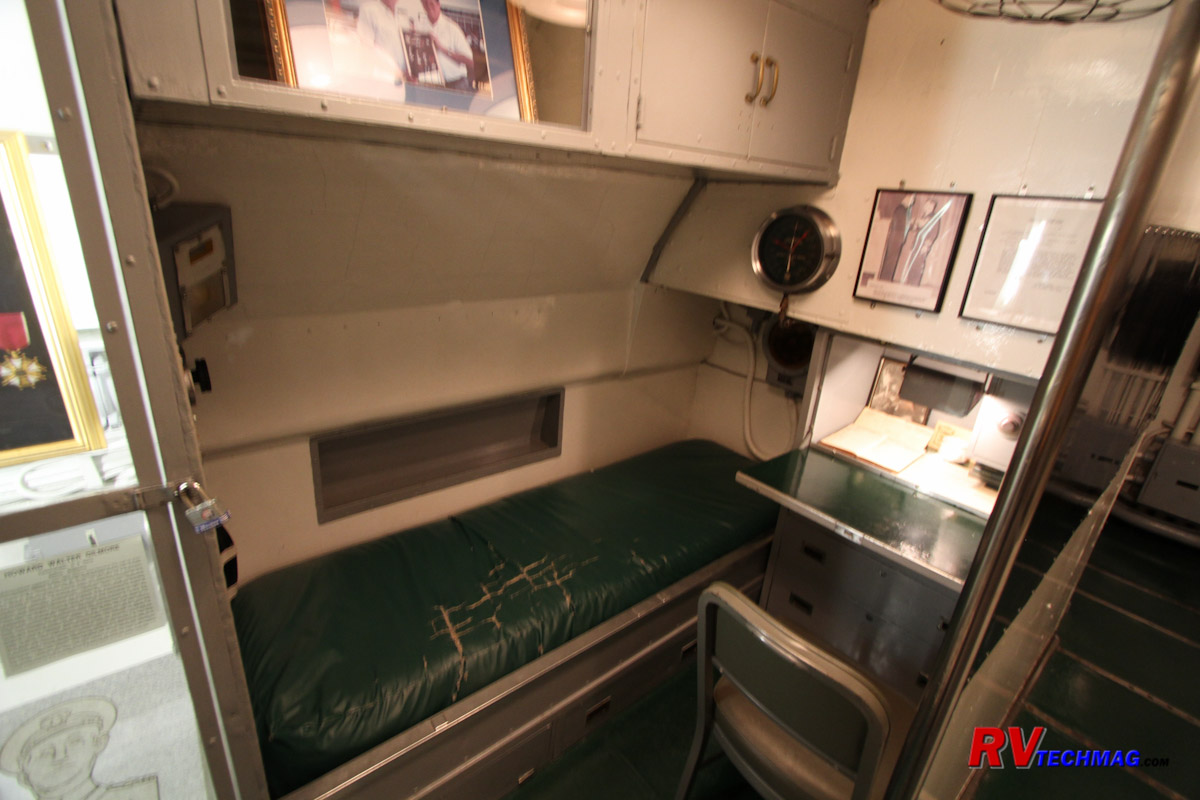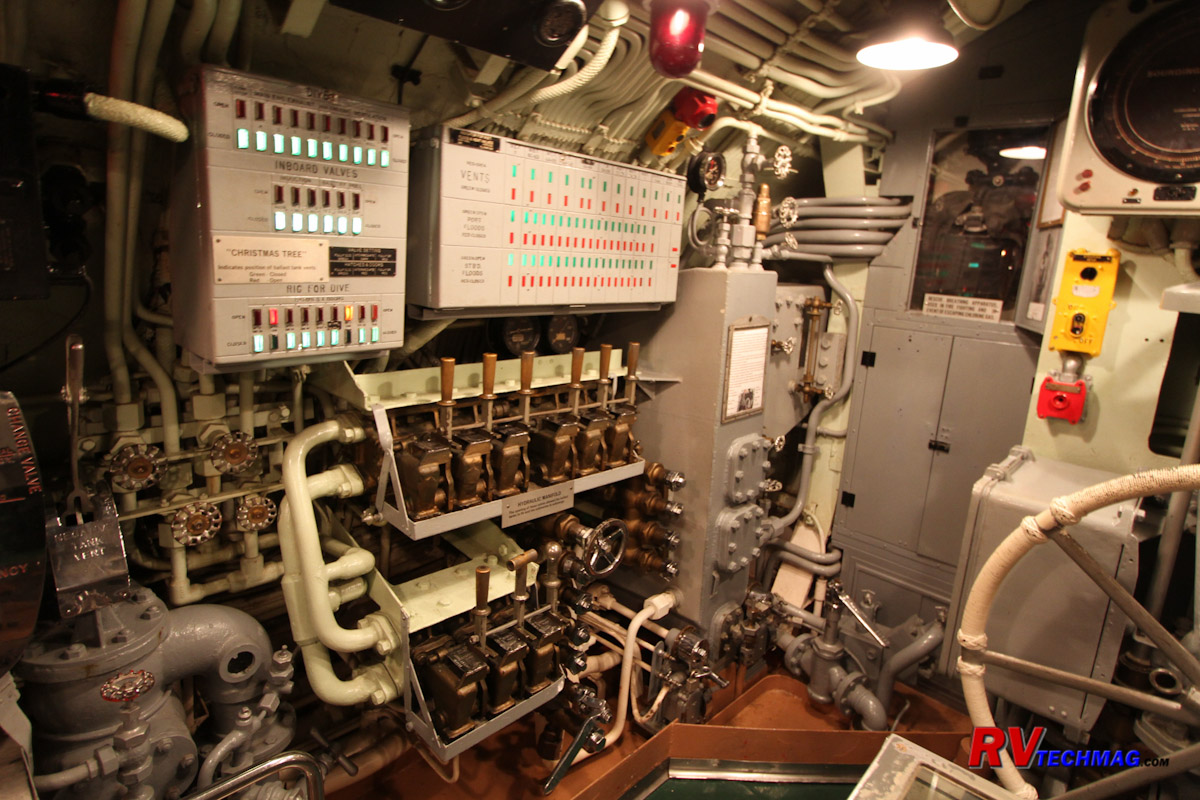USS Alabama
Exploring Mobile's Battleship Park
Article Date: April, 2016
Article and Photography by Mark Quasius
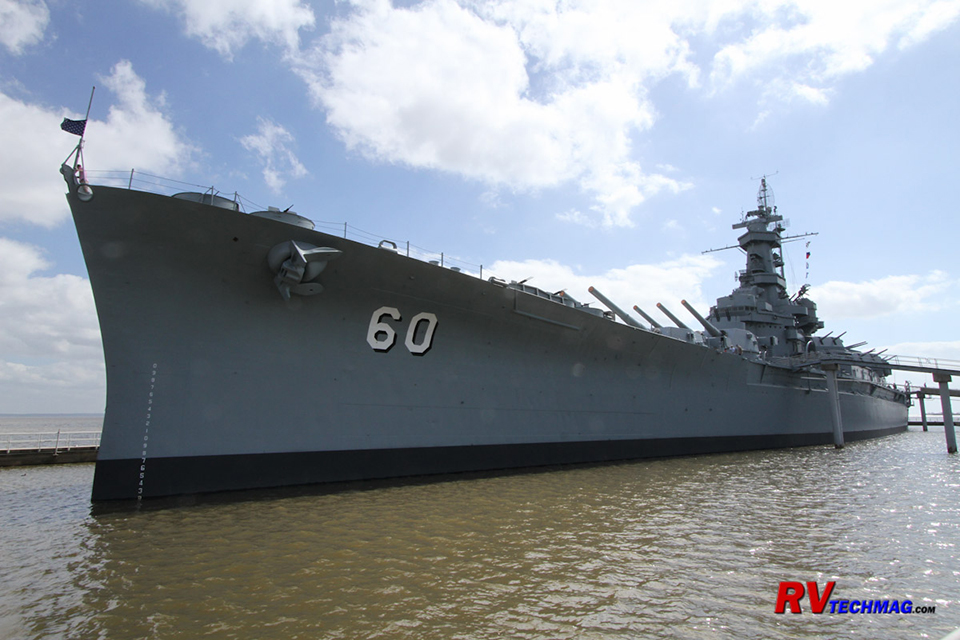
Preserving our history is important must much of the time we don't recognize an event or location as
historical until it is too late. By that time the historical artifacts have been removed or allowed to decay. World War II was
a significant event in our history. As we look back at how the war affected the entire world we see the need to educate modern
generations to show them just what the United States went through. Unfortunately there are very few veterans left from that era
to tell the story. Once the war ended there was no need to keep the ships, planes and machinery used by the armed forces and the
cost to maintain it was exorbitant so much was either sold, dismantled
or left to rust.
Fortunately there were a few visionaries who wanted to preserve these historical items from
disappearing
forever and efforts were made to acquire what they could as a memorial to those who fought in that war. Such is the story of the
USS Alabama and the USS Drum.
Alabama's Beginnings
After the December 11, 1941 attack on Pearl Harbor the United States was in serious need of military
equipment to use in our war with Japan. A large number of battleships had been sunk or damaged in that attack so the need for
battleship support for our troops was great. The USS Alabama was commissioned on August 16, 1942 and was a member of the South
Dakota class of battleships. After a brief tour of duty assisting the British fleet in Europe the Alabama was sent to the Pacific
where it began 37 months of active duty, earning nine battle stars. Known as the "Mighty A" she never suffered any casualties or
significant damage and carried her crew safely throughout her campaigns. After the war she was mothballed in the Puget Sound at
Bremerton, Washington.
Mothballed ships became a financial burden so in 1962 the Navy announced that the Alabama and many other
ships would be scrapped. In 1964 a campaign was launched to bring the Mighty A home to Alabama. School children raised almost
$100,000 in small change to bring her to her final resting place and corporate
fundraising raised the remainder of the $1 million
need to tow the ship to Alabama, which even today is considered the
longest ton/tow in history. On January 9, 1965 the USS Alabama
was opened to the public. Since then 15 million visitors have stood on her decks. In 1969 the submarine USS Drum, a world War II
veteran with 12 battle stars, joined the Alabama in battleship park.
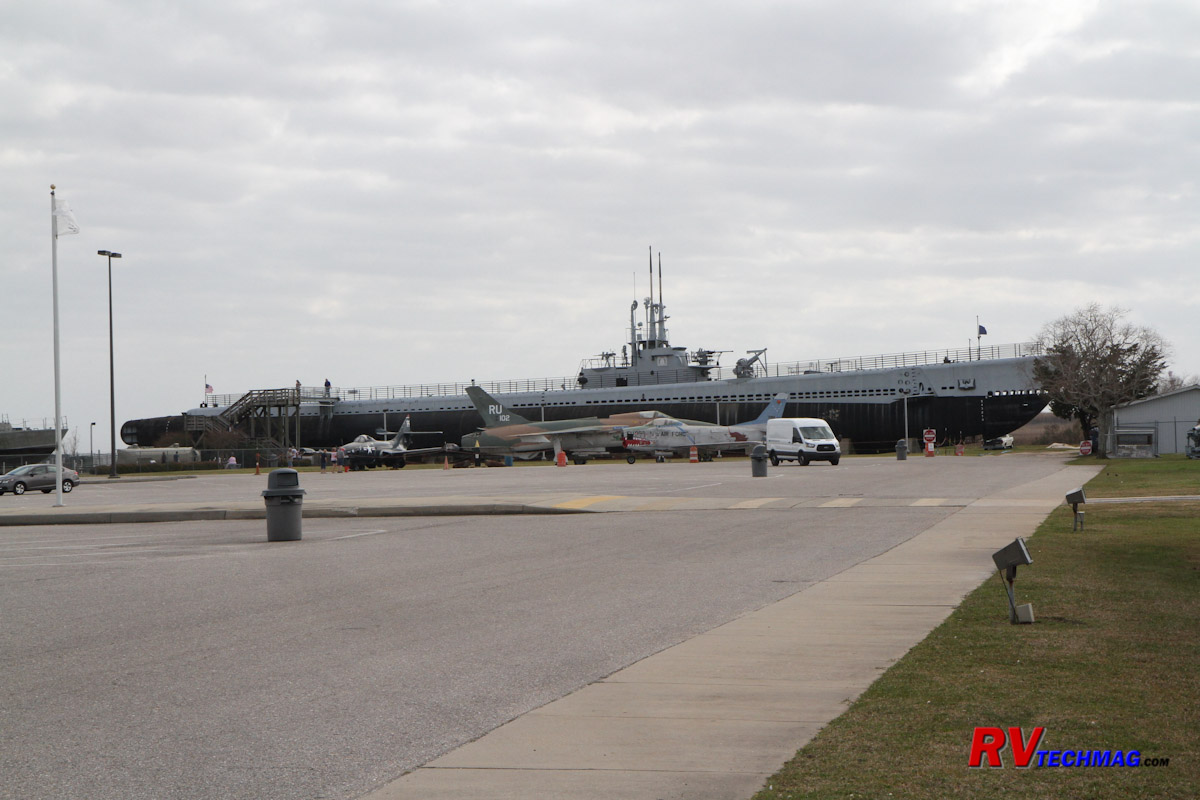
The World War II submarine, USS Drum, is on permanent display near the end of the parking lot in Battleship Park.
Battleship Park
Battleship Park has grown over the years. In addition to the USS Alabama, its main feature, the USS Drum is
proudly displayed. Several air craft are on outside display as well, including a C47 Skytrain, B25 Mitchell and B52 Stratofortress.
more aircraft are kept inside in the Aircraft Pavilion. This climate controlled museum keeps the planes in pristine condition and gives
visitors the chance to learn more about them. A number of planes are kept here , from World War II warbirds up through the SR-71
Blackbird spy plane. A flight simulator is also available for those who want to try their hand at flying a jet fighter. An Honor Wall
honors Alabama's Medal of Honor recipients. There are also numerous memorials outside in the park honoring
heroes, including a War Dogs
memorial.
There is also a large section devoted to military vehicles. Several pierces are on loan from the Smithsonian
Institution, including a 155mm field piece and a 120mm Skysweeper anti-aircraft gun. Tanks from various eras are on display, including
a T-55 Iraqi tank, an M4 Sherman tank and a M60A1 tank. A PBR gunboat from the Vietnam theatre in also located inside the Aircraft Pavilion.
|
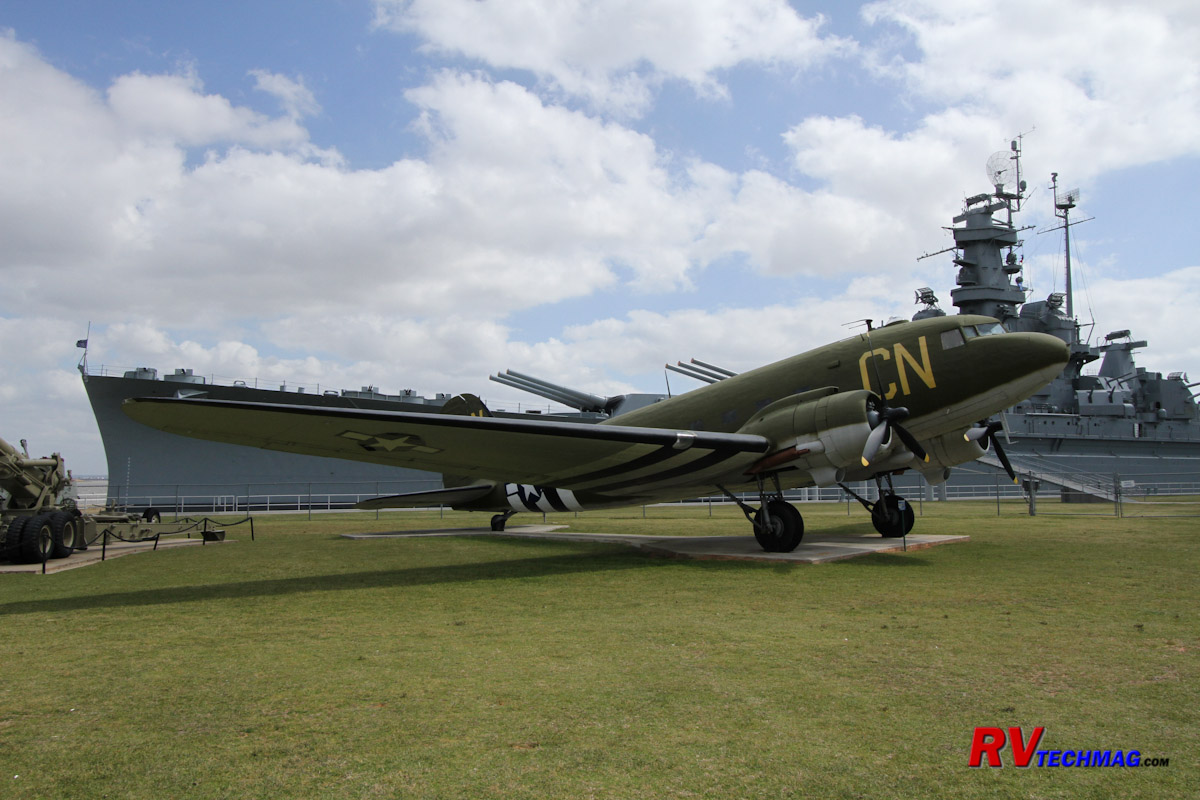
A number of aircraft are on display in the park, such as this C47 Skytrain used to drop paratroopers on D day.
|
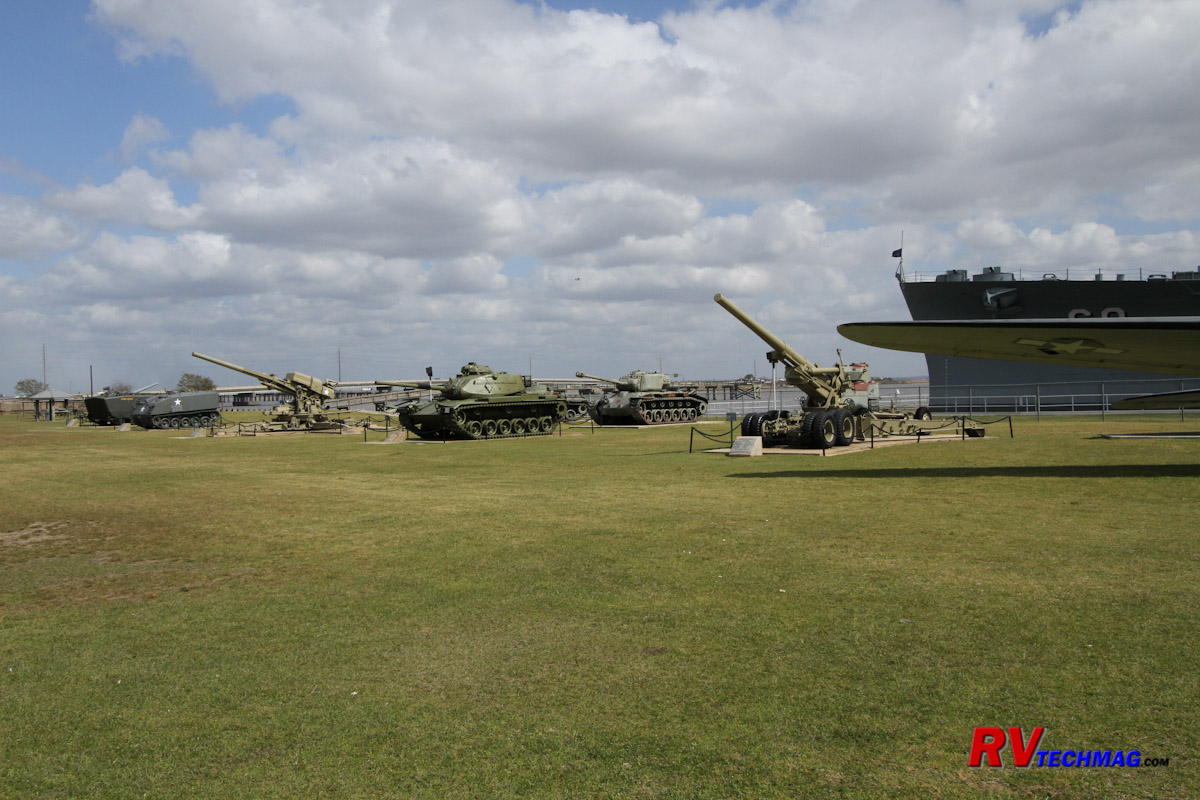
A large selection of tanks and artillery pieces are on display, including some on loan from
the Smithsonian Institution.
|
Touring the Alabama
The Alabama is big. It displaces more than 44,500 tons and measures 680 feet from stem to stern, half as long
as the Empire State Building is tall. Her steel armor was a foot thick above the waterline and each propeller weighed 18 tons and
could drive the ship through the seas at up to 28 knots, which is more than 32 miles per hour.

When loaded with 7,000 tons of fuel oil, her range was about 15,000 nautical miles. With a beam (width) of 108',
it served as a great platform for her massive armament, culminating with nine 16" guns in three turrets. In wartime her full
complement was a crew of 2,354 men.
|
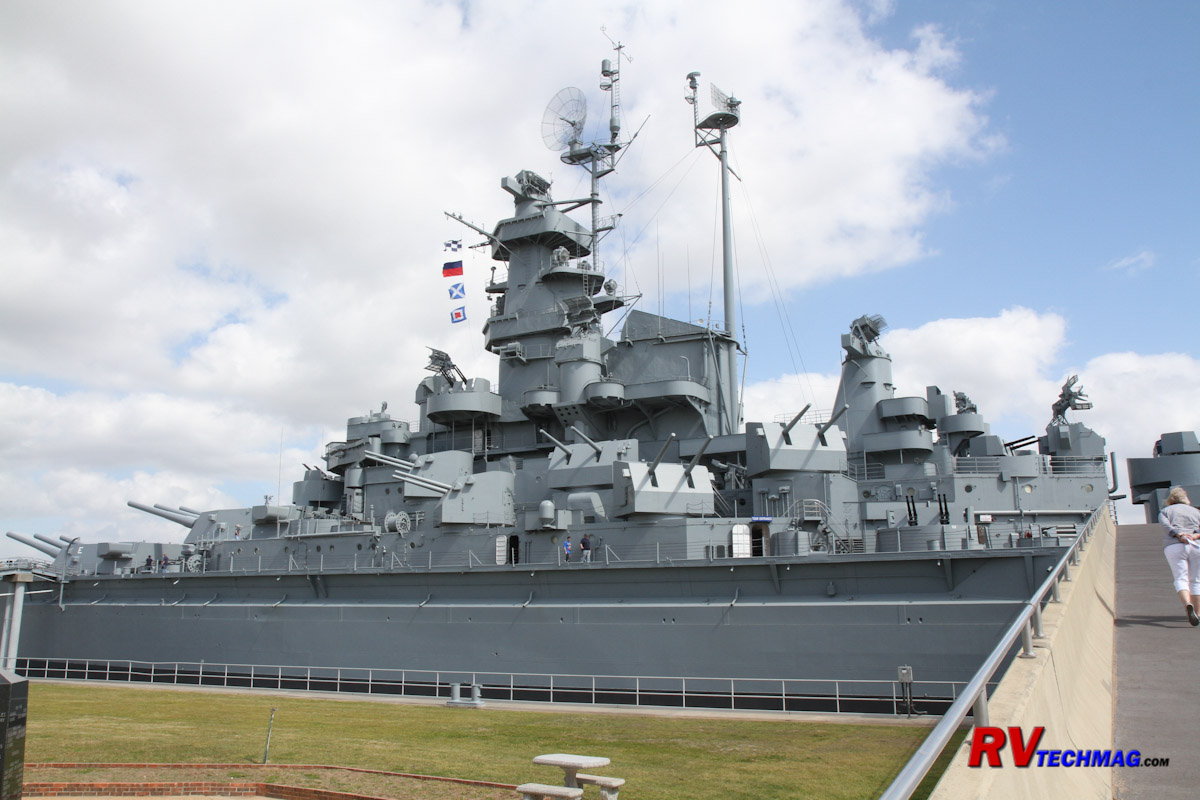
A total of 20 5" guns were placed in 10 armored turrets, 5 on each side of the ship.
|

A large number of anti-aircraft guns were located on the ship, including these 20mm Oerlikon cannons.
|
In addition to her 16" guns, the Alabama was equipped with 20 5" guns, 24 40mm Bofors anti-aircraft guns and
22 20mm Oerlikon cannons, although that number was always increasing as the war went on. After Pearl Harbor the Navy recognized the growing
threat from aircraft so the Alabama bristled with anti-aircraft gun emplacements and was credited with downing 22 enemy aircraft.
Main Armament
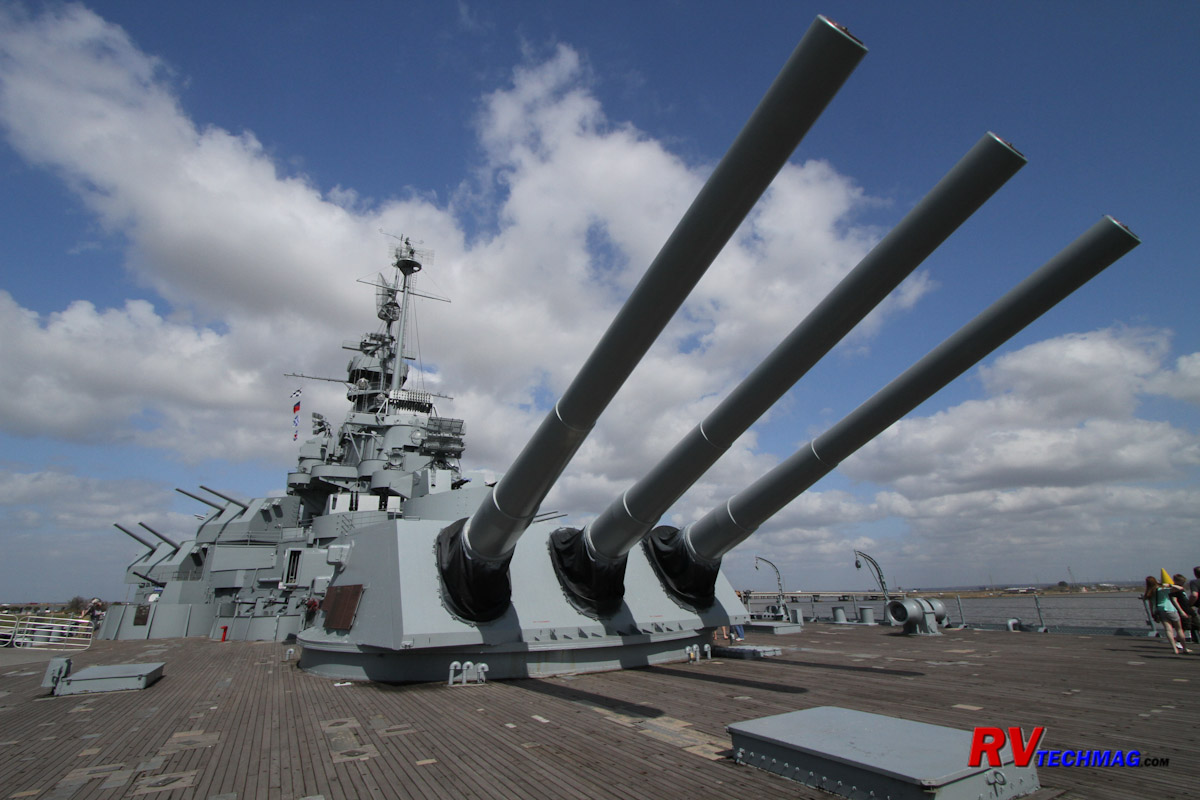
The 16" guns are the distinguishing mark of the USS Alabama. Nine of these large guns are set into groups of three
into three turrets equipped with 18" thick armor. Two turrets are located on the ship's bow while a third is located on the stern. These guns
are capable of hurling a 2,700 lb. projectile with pinpoint accuracy over 20 miles at a speed of 2,300 feet per second, which is equal to
1,568 miles per hour or twice the speed of sound. Powder and projectiles were stored below decks and raised to the turrets by elevators.
|

This unrestored portion of one of the 16" gun turrets shows the cramped quarters the sailors had to work in. Passageways, outlined
in fading red paint, marked access portals to the crew that loaded the gun barrels.
|
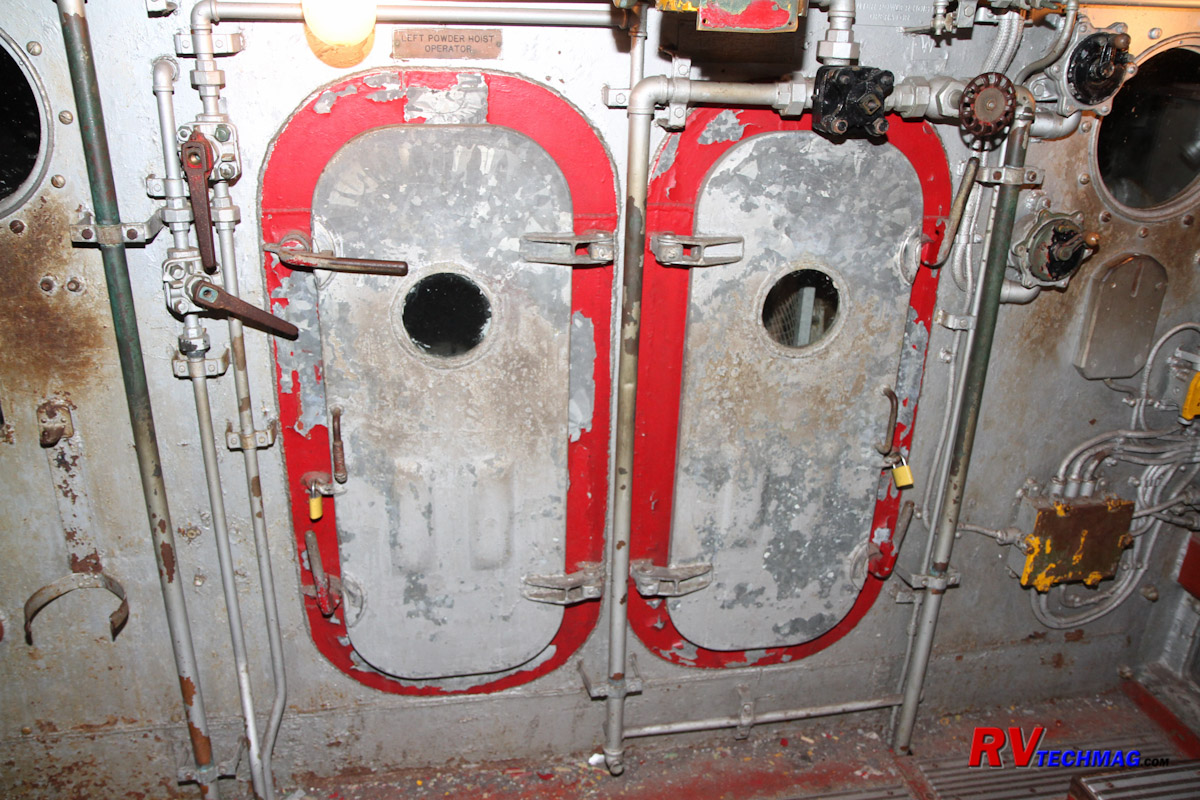
Powder containers were stored below decks and lifted via an elevator mechanism into each turret. Due to the explosive nature of
the powder, it was stored and handled separately from any area that could be susceptible to sparks.
|
|
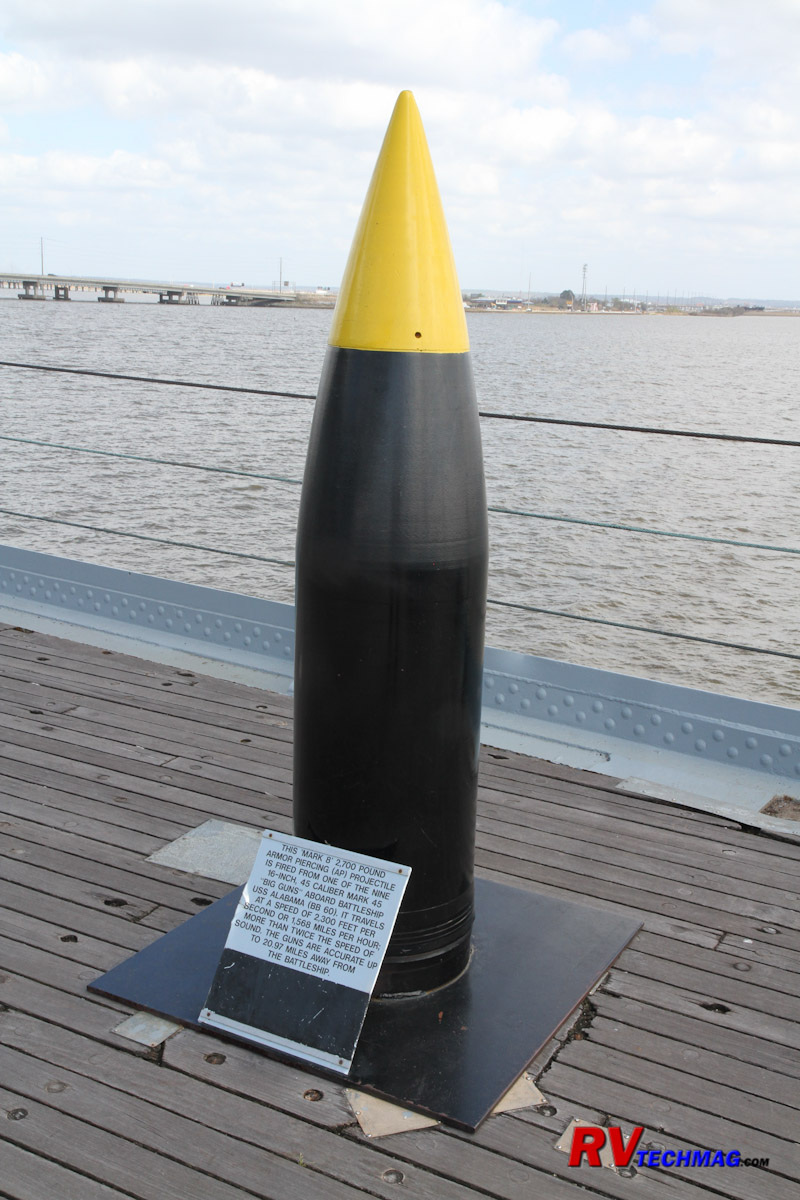
This armor piercing projectile is fired from the 16" guns and travels at twice the speed of sound.
|

Two 16" gun turrets are located on the bow of the ship on two levels. The forward fire control towers are located above and to
the rear of the turrets.
|
5" Turret Interiors
|
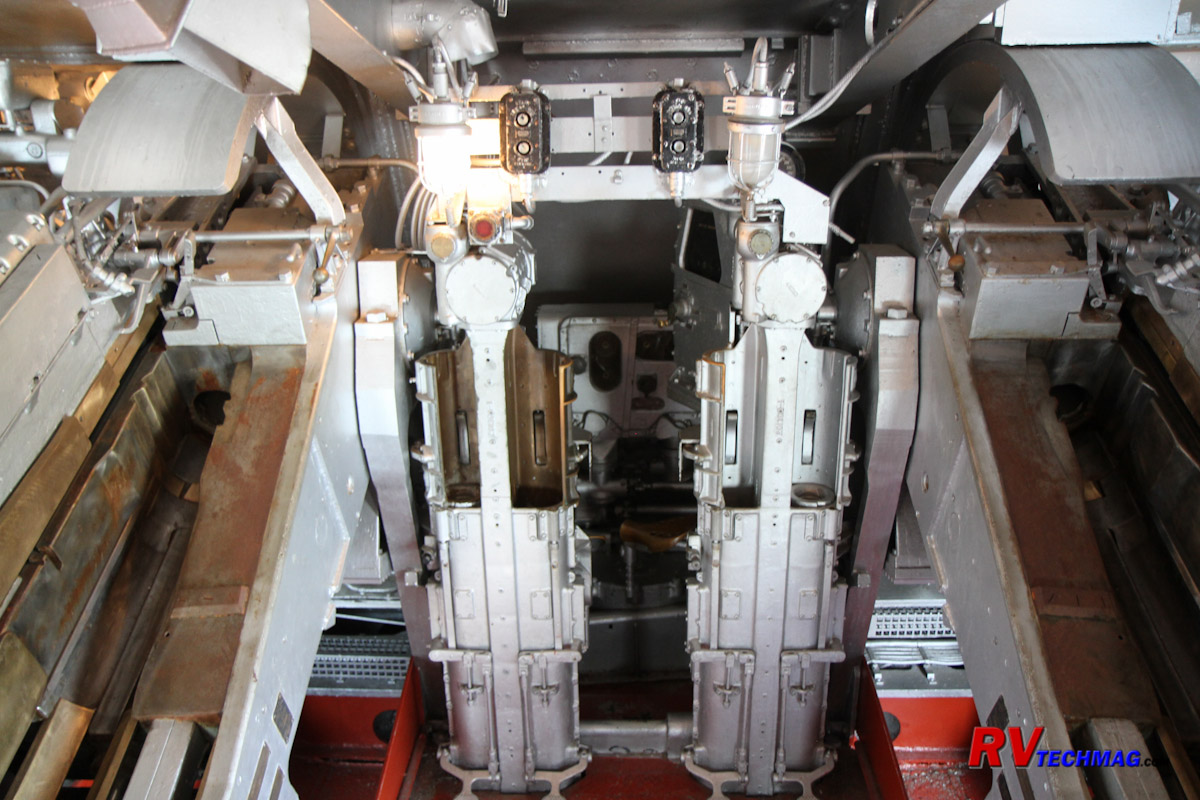
The 5" turrets housed a pair of 5" guns. Ammunition was raised via elevator tubes and loaded into the breeches of the two guns.
|
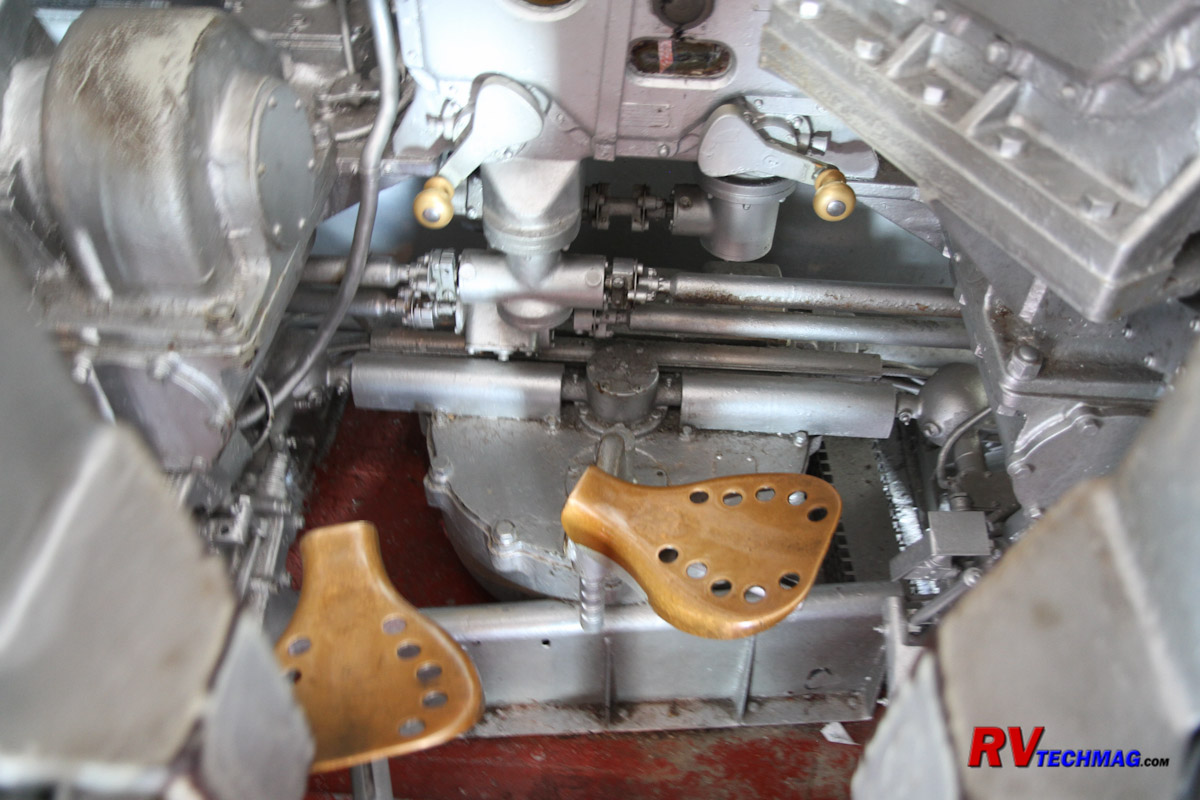
The seating positions to operate the gun's traverse and elevation controls inside the cramped turret were not overly roomy.
|
Spotting Planes
With the big guns range of over 20 miles it was necessary to have a visual of the target area. A pair of OS2U
Kingfisher spotting planes was mounted on two catapults on the rear
deck of the ship. These floatplanes could be launched down the catapults and
used to observe the target area, radioing back information to the ship's fire control officers to adjust their targeting accordingly. When
done with their spotting tasks the floatplane would return to the Alabama and land in the sea next to the ship. A large crane would lift them out
of the sea and place them back on the catapults to be made ready for the next spotting mission.
|
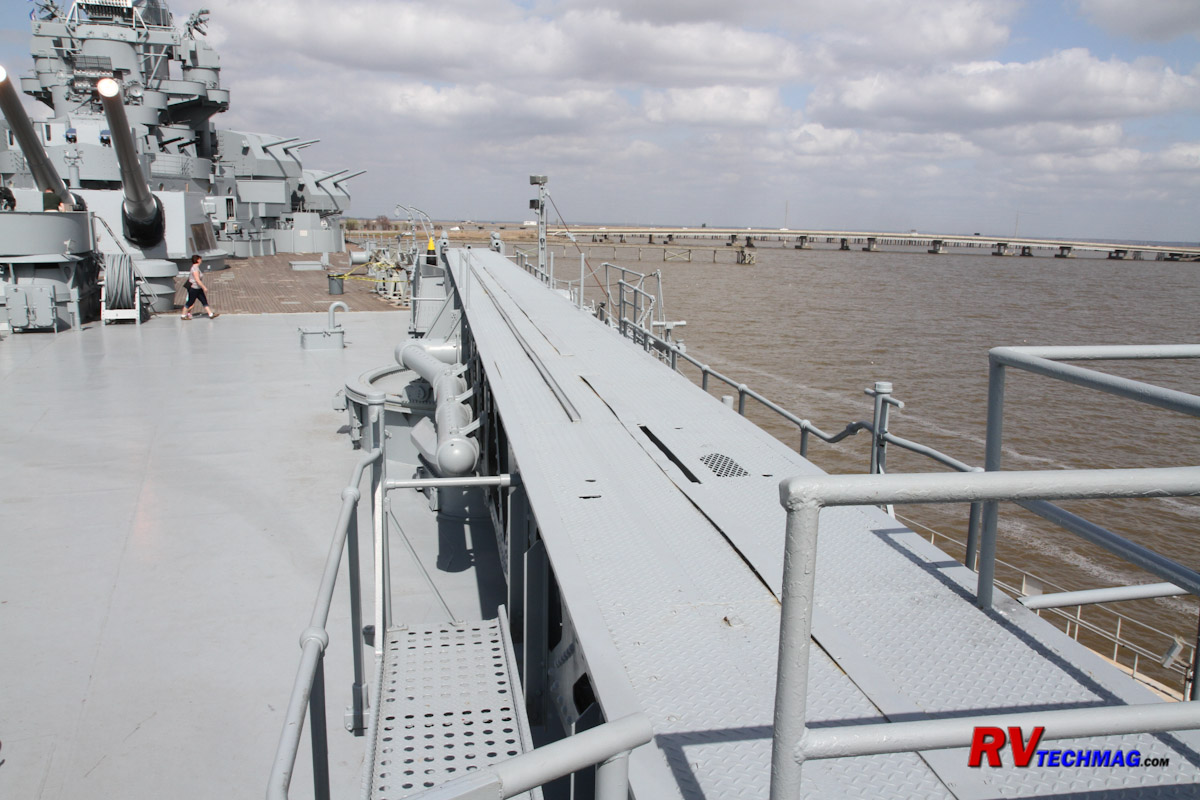
A pair of catapults were mounted on the stern of the battleship.
|
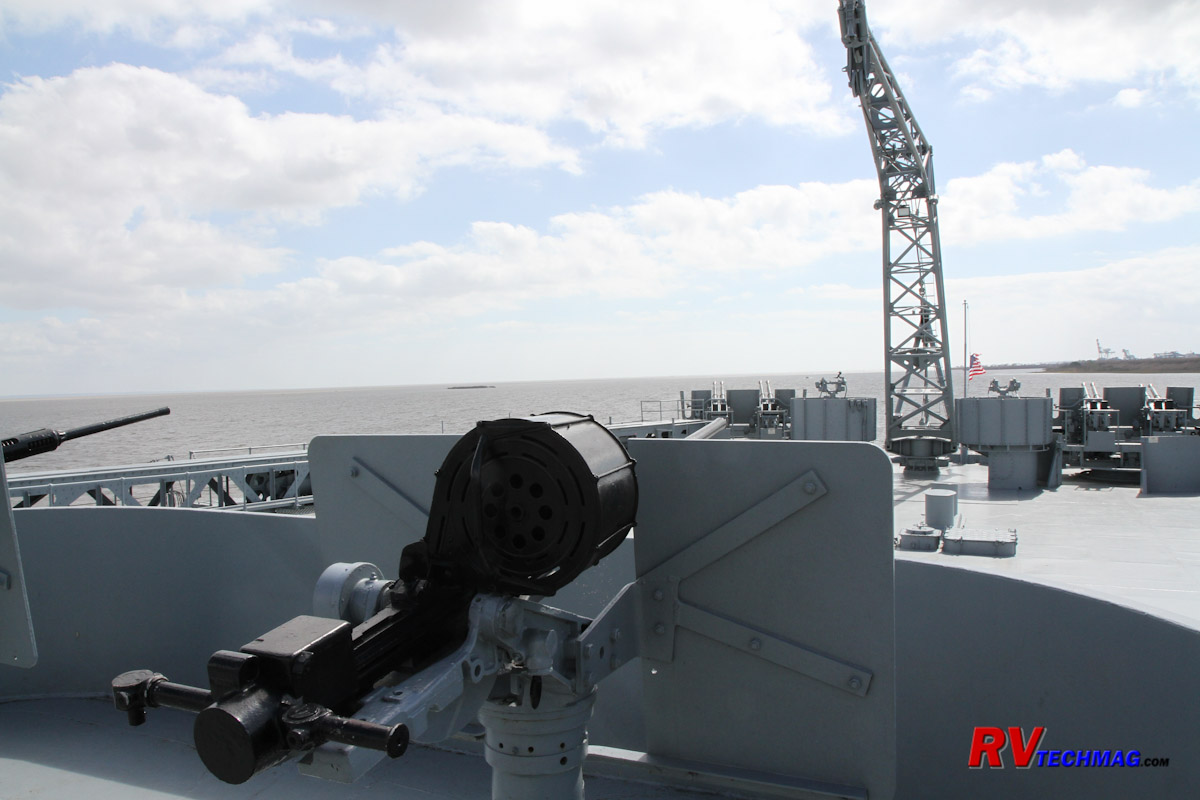
A large crane boom was used to retrieve the floatplanes from the sea.
|
Above Deck
The Alabama had numerous above deck areas, such as the signal flag area, capstans, and other related areas.
The forward water deck was decked with teak planking to prevent slipping and housed the anchor chains, a battery of anti-aircraft guns
and the apparatus for launching the anti-mine paravane.
|
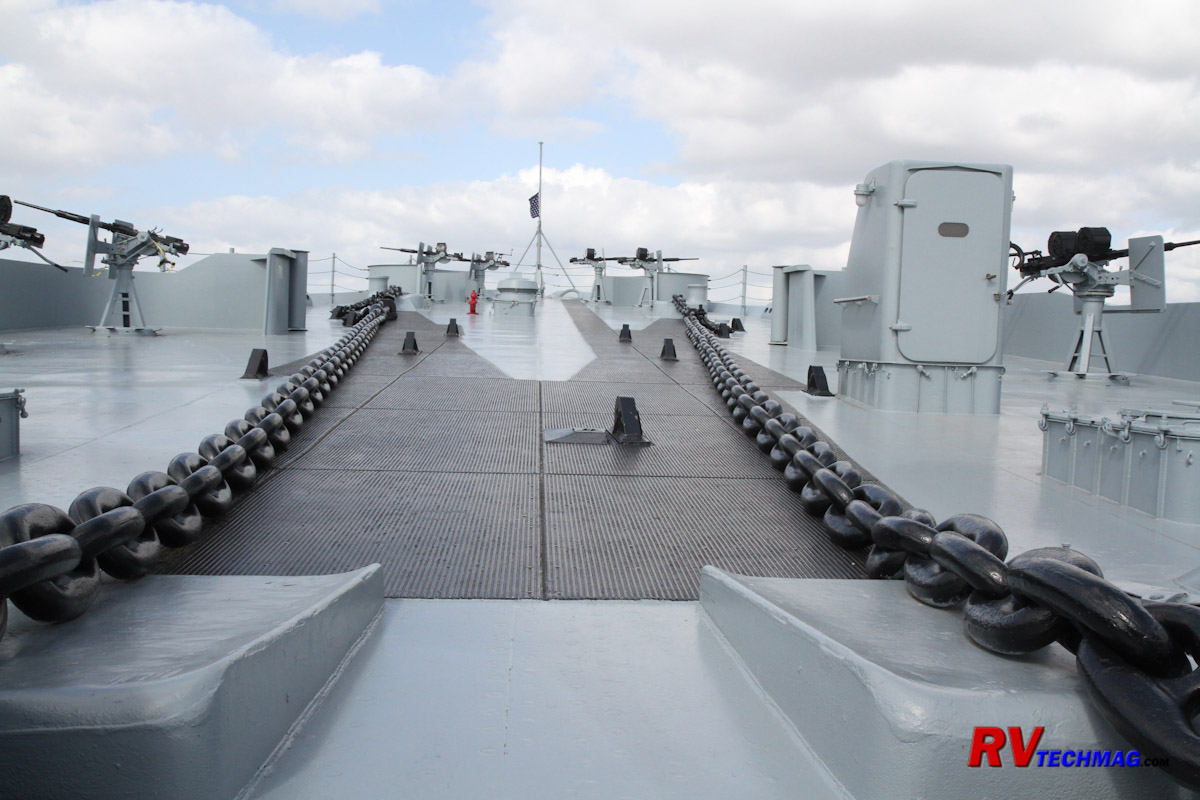
Heavy sea anchors were required to anchor the 44,500 ton Alabama. A pair of massive anchor chains ran the length of the
forward water deck, which was filled with anti-aircraft guns.
|
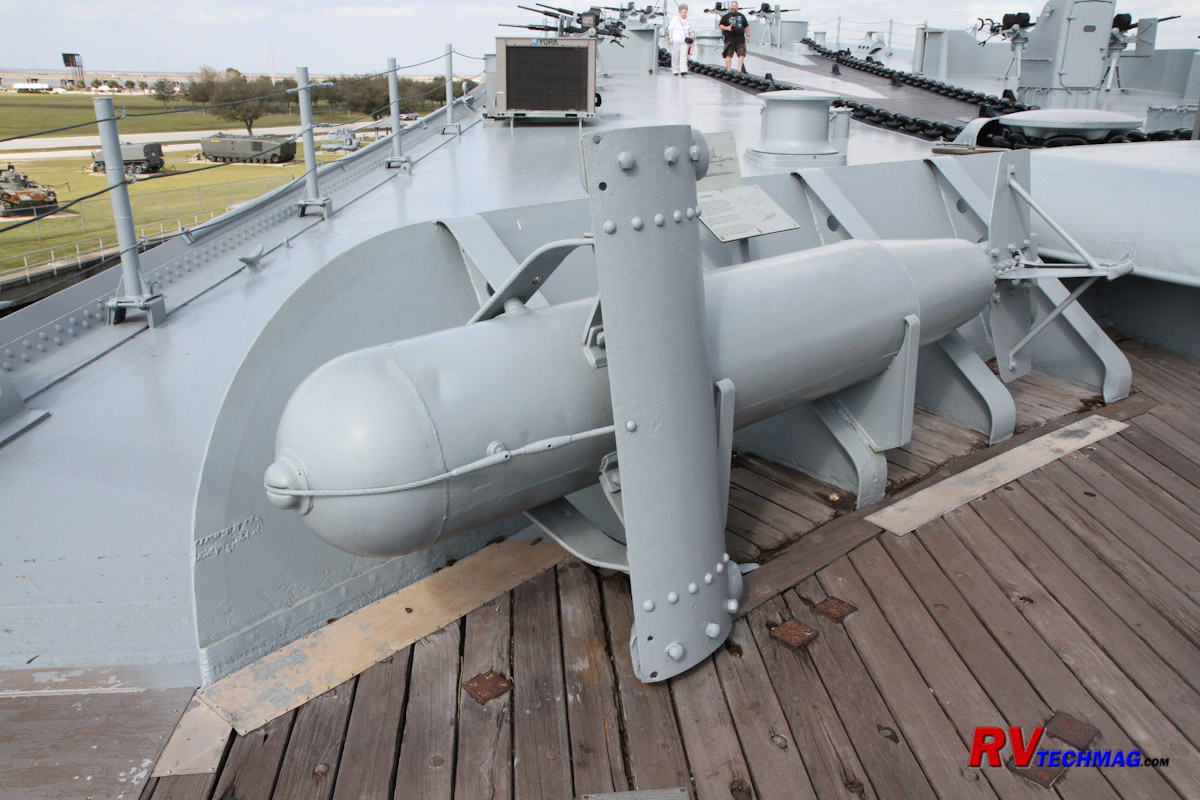
Mines were always a threat to warships. The Alabama was equipped with
paravanes, a type of water kite that is launched from
the water deck and cruises away from the sides of the ship at its designated depth. It is attached to the ship with cables
and is designed to snag any mines and cut their cables. This allows them to float to the surface where they can be destroyed
by naval gunfire.
|
Below Deck
There are three self-guided tours of the USS Alabama. You'll need to bring good walking shoes and no open toed
shoes or sandals because you will be climbing up and down between decks. Each tour is marked with red, green or yellow lines and arrows.
Various stations have numbers so that you can navigate through the ship's bowels. But the ship is large and losing your bearings isn't
hard to do. The ideal way is to download the USS Alabama tour app to your
smart phone. You can select which of the three tour routes you
want to use and follow the directions displayed on your phone. Not only will this help you navigate but it will give you some great
information and interesting facts about each area as you progress.
|

Locked storage compartments, such as this food locker were found below deck near the crew berthing and dining areas.
|
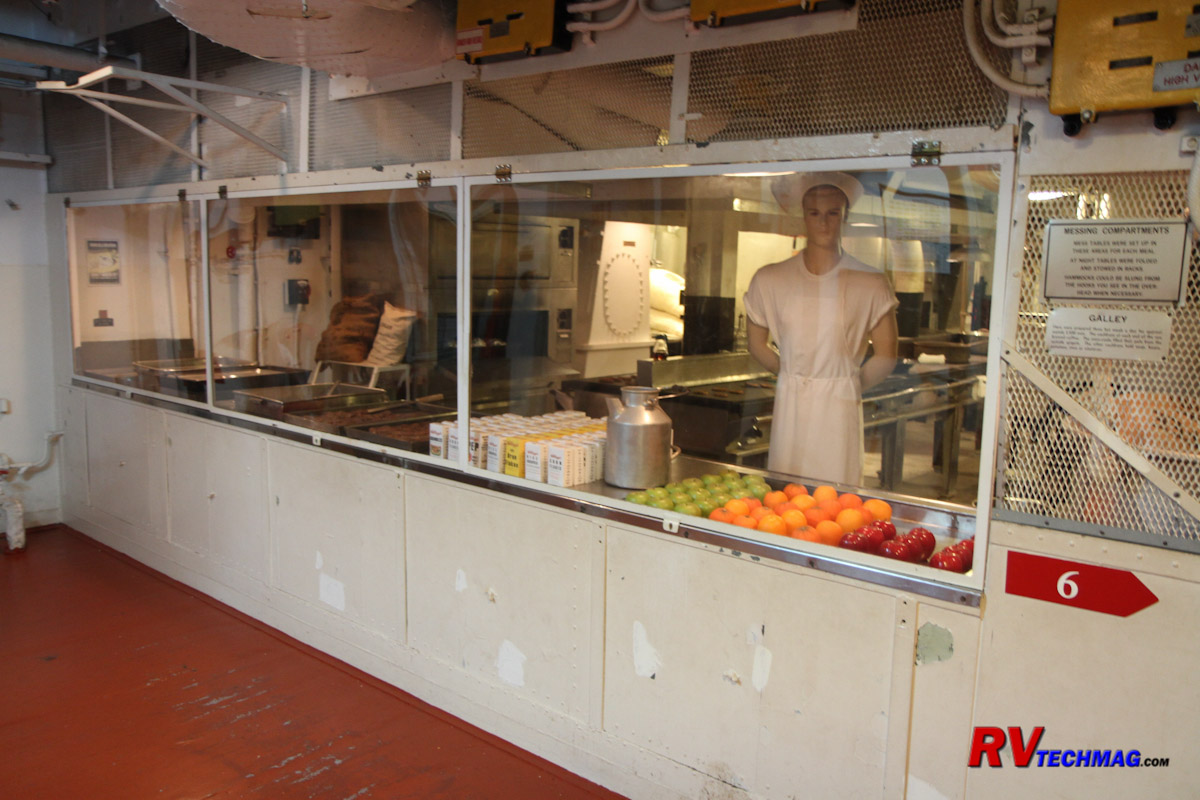
Battleships had plenty of storage space so the crews ate well while they were spending long months at sea. This is one of
the serving lines of the crews galley, where the feeding of 2,500 men three meals a day occurred in four shifts.
|
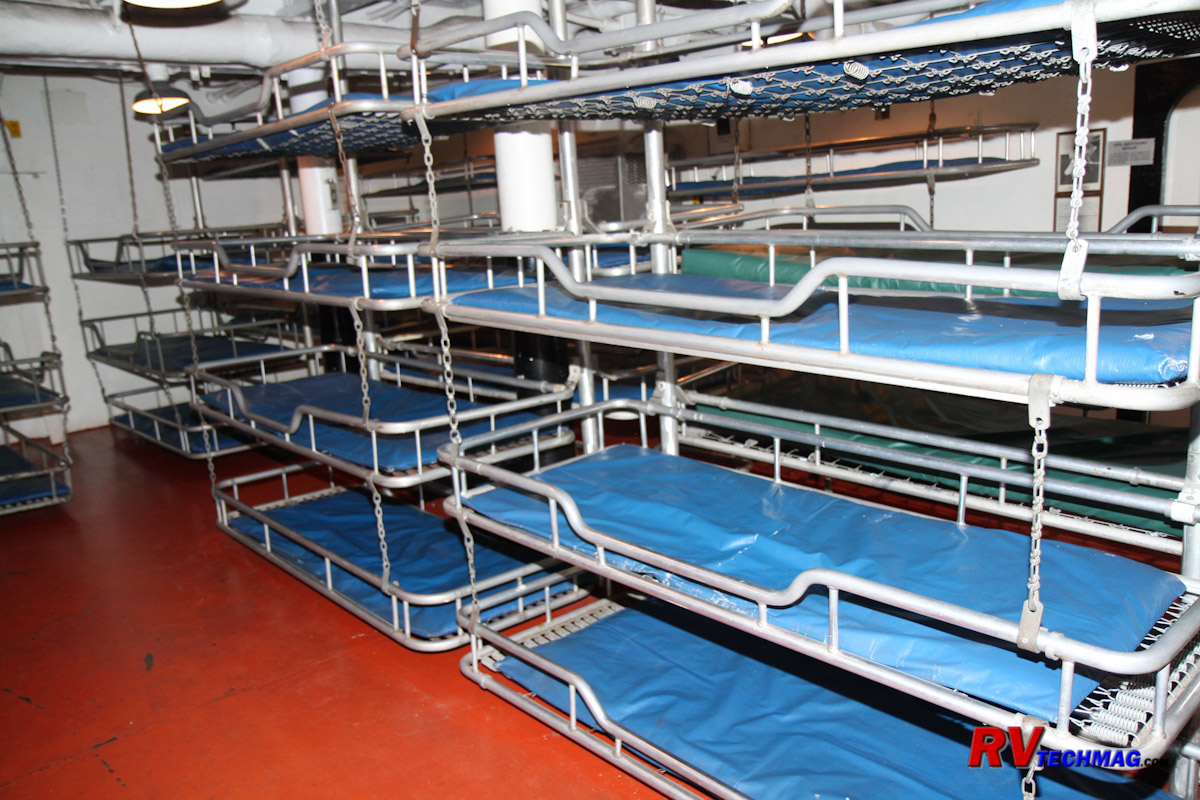
The crew was berthed three levels below the main deck, directly beneath the galley. Men were stacked up to four
layers high in bed racks suspended by chains to allow for movement during pitching seas to prevent falling out of bed. Areas were to be
kept clean with personal effects stored in lockers. Any items left remaining were collected by the Master at Arms and the crew member was
given a few hours of extra duty when reclaiming them.
Ship's Museum
There are many exhibits on display throughout the ship that will offer a glimpse of what life was like aboard ship.
In particular one section was devoted to kamikaze attacks, which the Alabama was able to successfully fend off.
|
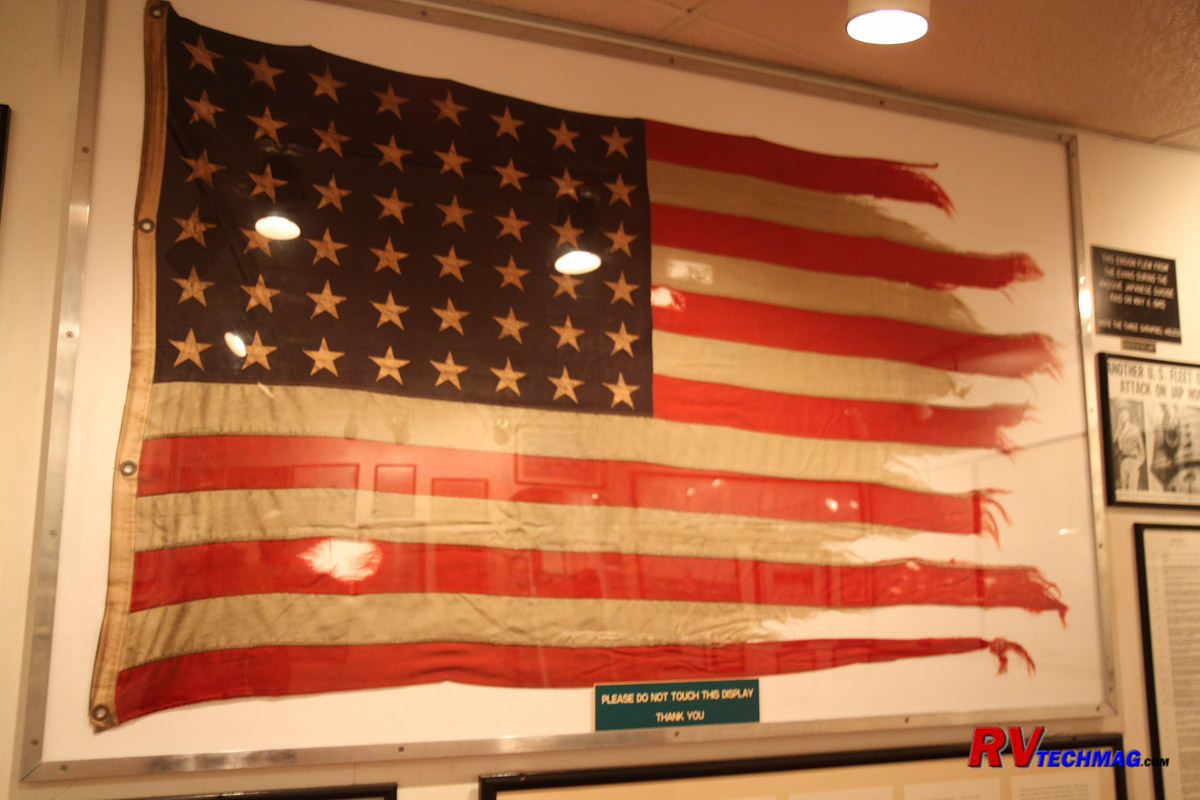
This ensign flew over the USS Evans, an escorting destroyer that was attacked for two days by more than one hundred kamikazes
on May 10th and 11th, 1945. The ship was struck by four kamikazes but the crew managed to save the ship although 32 crew
members were killed and 27 wounded. Three shrapnel holes are visible in the flag. The ship was awarded the Presidential Unit
Citation for high gallantry and achievement.
The fragments displayed in the image to the right are from a Japanese aircraft that struck the USS Mississippi, killing 26 sailors
and wounding 63 other crewmen while in Lingayen Gulf in the
Philippines.
|
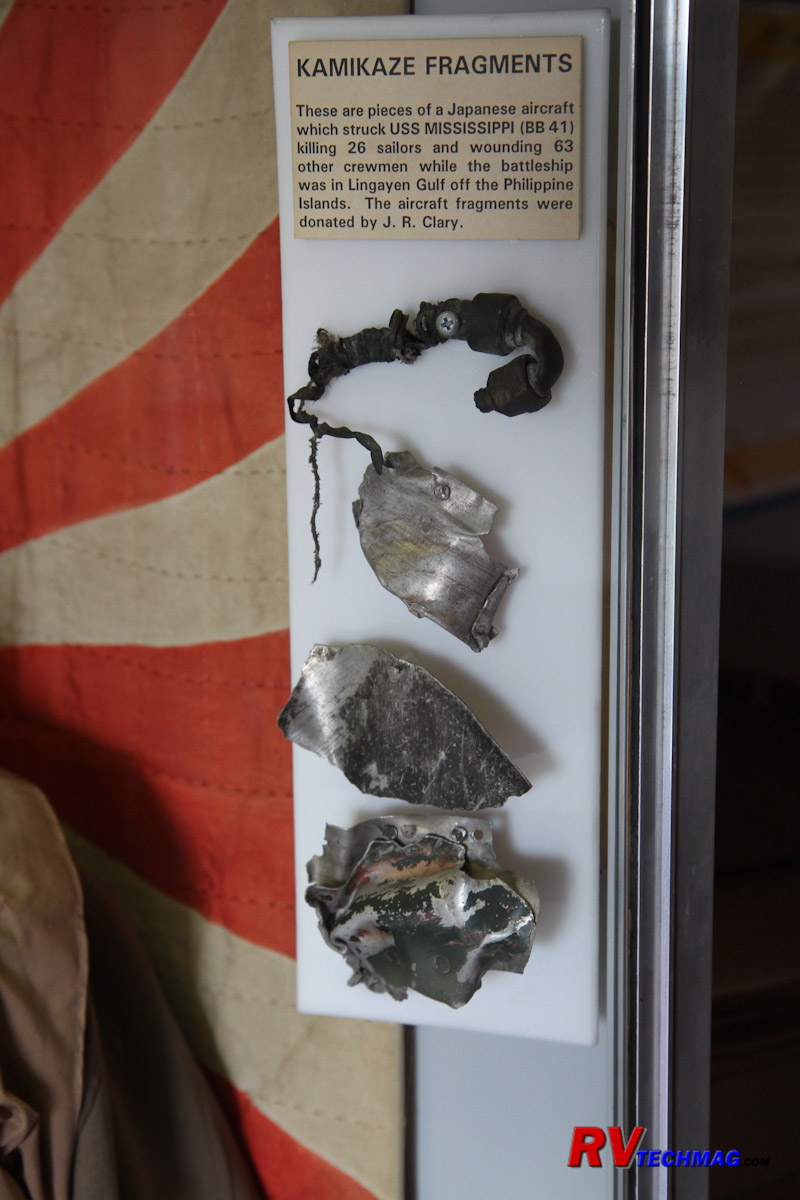
|
The USS Alabama has a storied history. The ship led the fleet into Tokyo Bay for the signing of the formal
surrender documents. During the war she sailed 218,000 miles, shot down 22 enemy aircraft and received nine battler stars for participating
in significant action. Fortunately the efforts of the citizens of the state of Alabama were successful in saving this historical ship and
displaying it as a memorial to all Alabamans who fought in that war. Over 15 million visitors have toured the ship as it is now proudly
displayed in Mobile, AL. It is still retaining its stardom though as numerous Hollywood films were shot on the ship, such as a stand-in for
the USS Missouri in Under Siege, as the USS Iowa in War and Remembrance and as the USS Indianapolis in Men of Courage.

Aircraft Pavilion
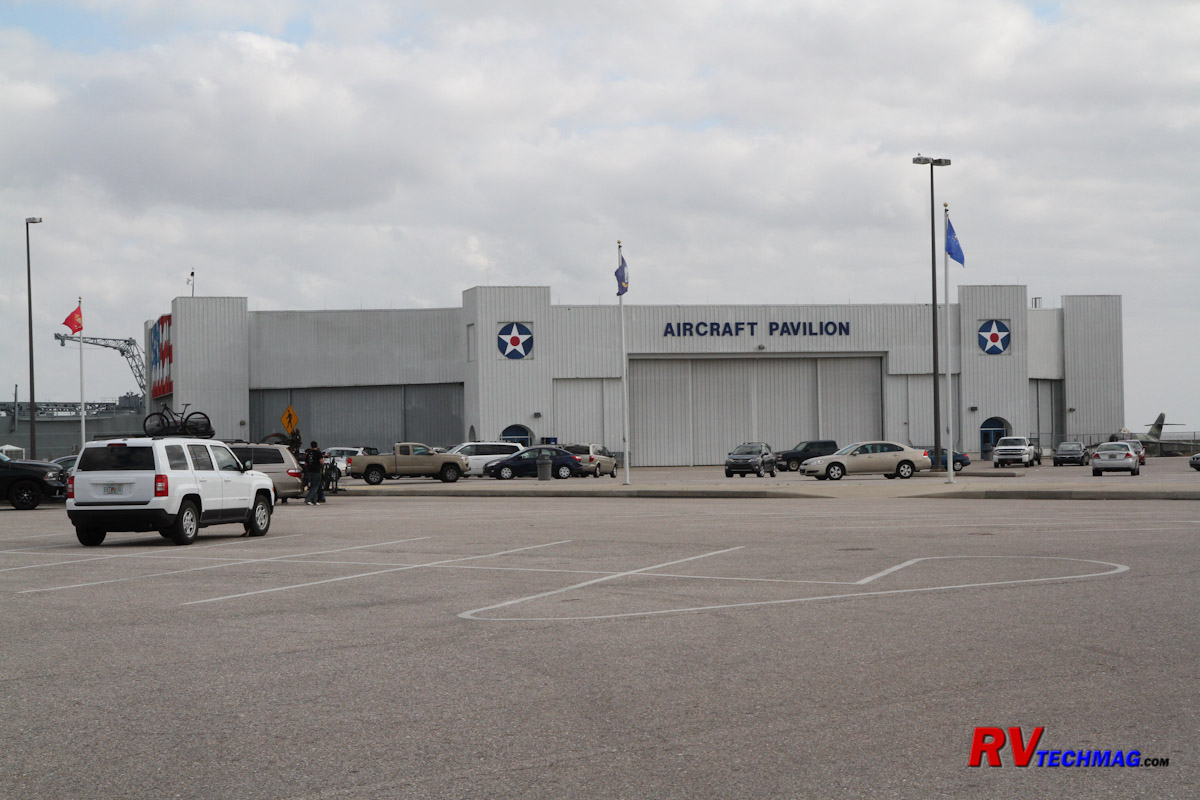
While there are a number of planes outside on the grounds, the real treasures are inside in the aircraft pavilion.
this building houses a number of significant aircraft as well as a simulator for guests and a number of interpretive exhibits, including a
Vietnam era PBR gunboat. World War II aircraft include the OS2U-3 Kingfisher from the USS Alabama and a P51D Mustang while jet age aircraft
range from the Korean War vintage F86L Sabre up through F14 Tomcats and F18A Hornets. One of the handful of mach 3 A-12 Blackbird spy planes
operated by the CIA is also on display.
|
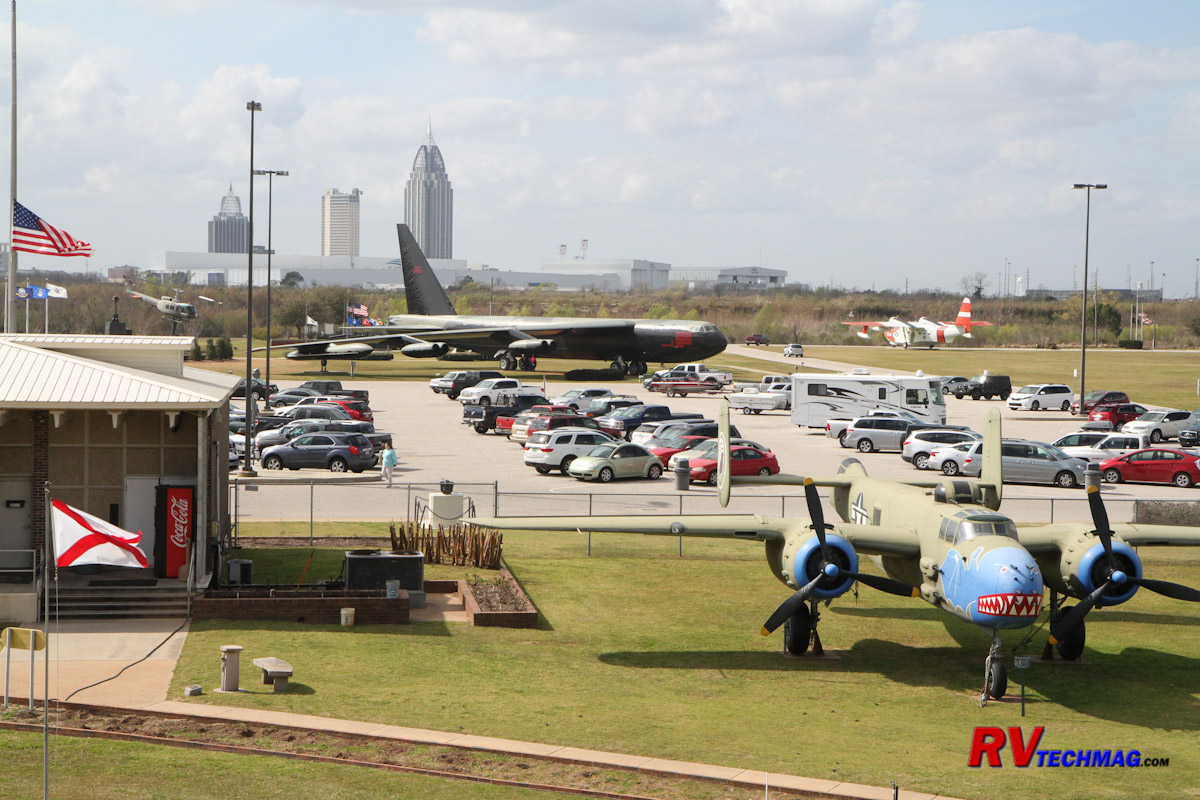
The parking lot outside the Aircraft Pavilion showcases planes such as this B25 Mitchell and a B52 Stratofortress.
|
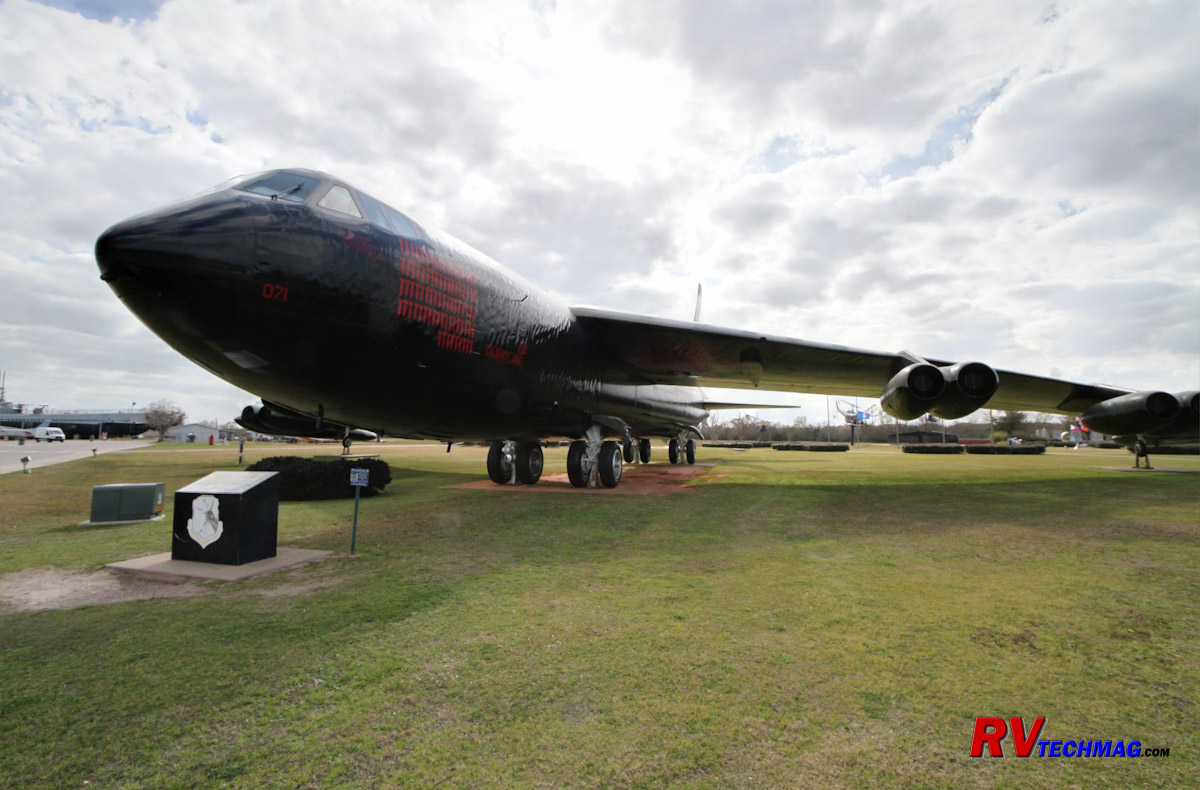
This B52, named "Calamity Jane" served in 90 bombing missions before being retired to Battleship Park.
|
|
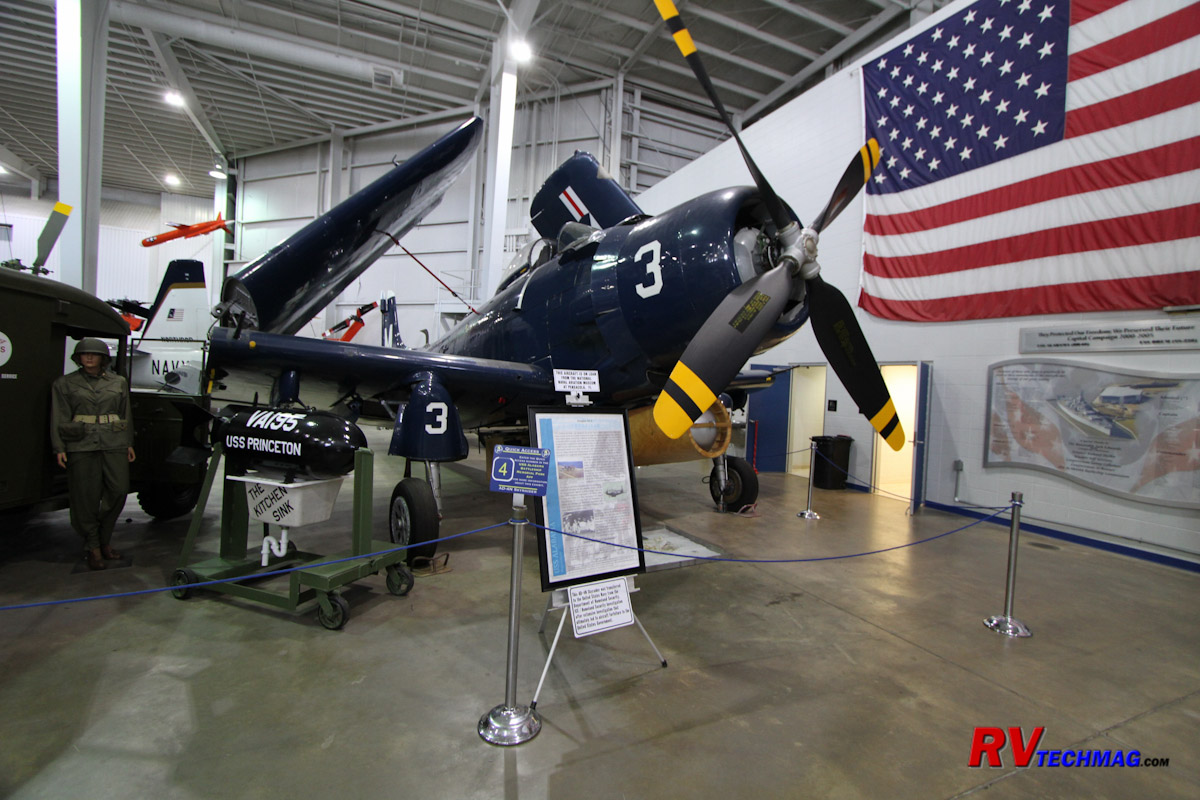
This AD-4N Skyraider was a heavy hauler attack aircraft used
throughout Korea and Vietnam and could haul up to 8,000
lbs. of ordnance.
|
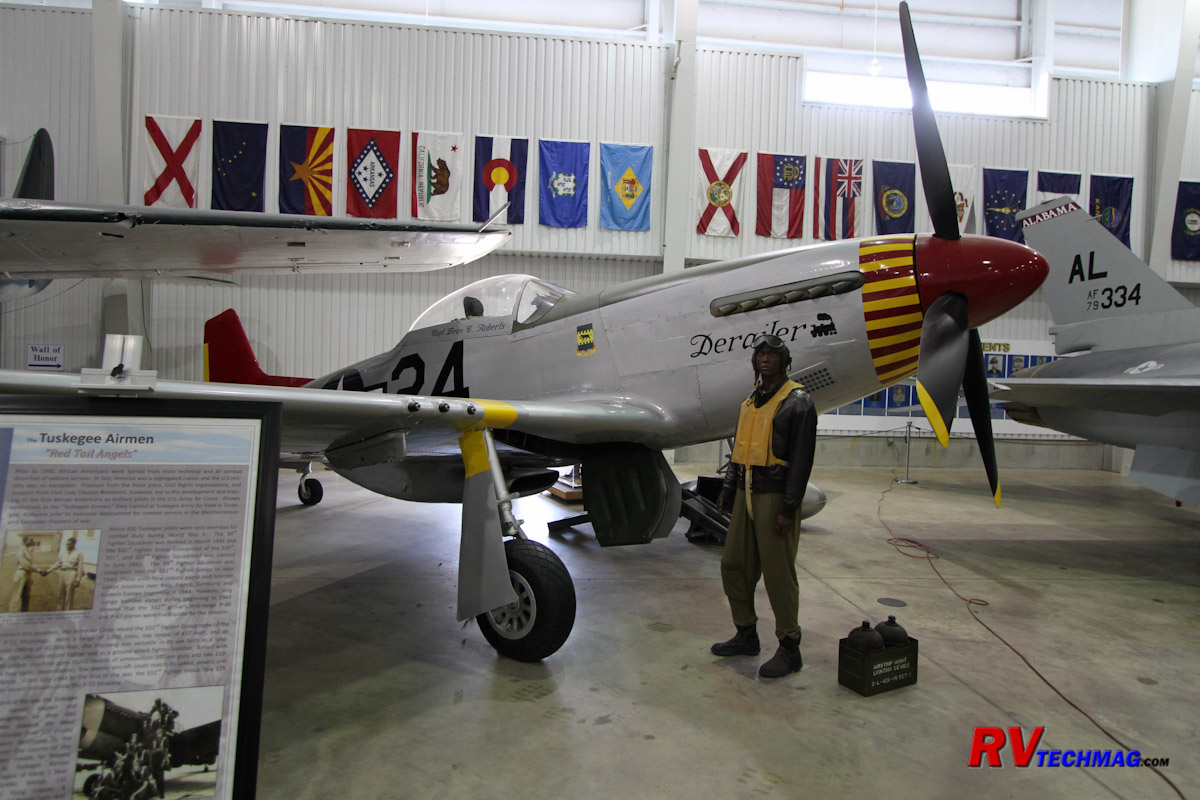
The P51D Mustang was the frontline fighter in World War II and had long distance escort capabilities to protect long
range bombers such as the B17 Flying Fortress.
|
|
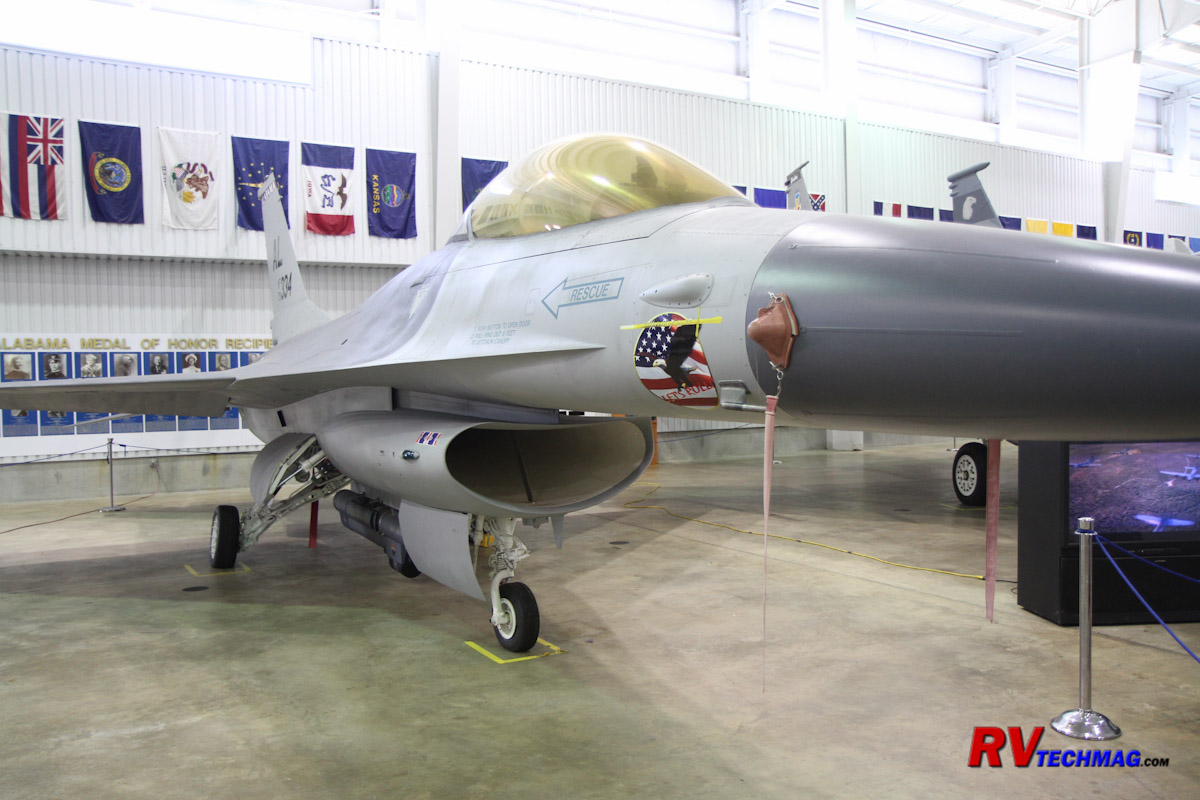
This F16 Fighting Falcon represents the modern era of jet fighters. Designed as an all-weather interceptor, this versatile
fighter was also adapted to Close Air Support roles.
|
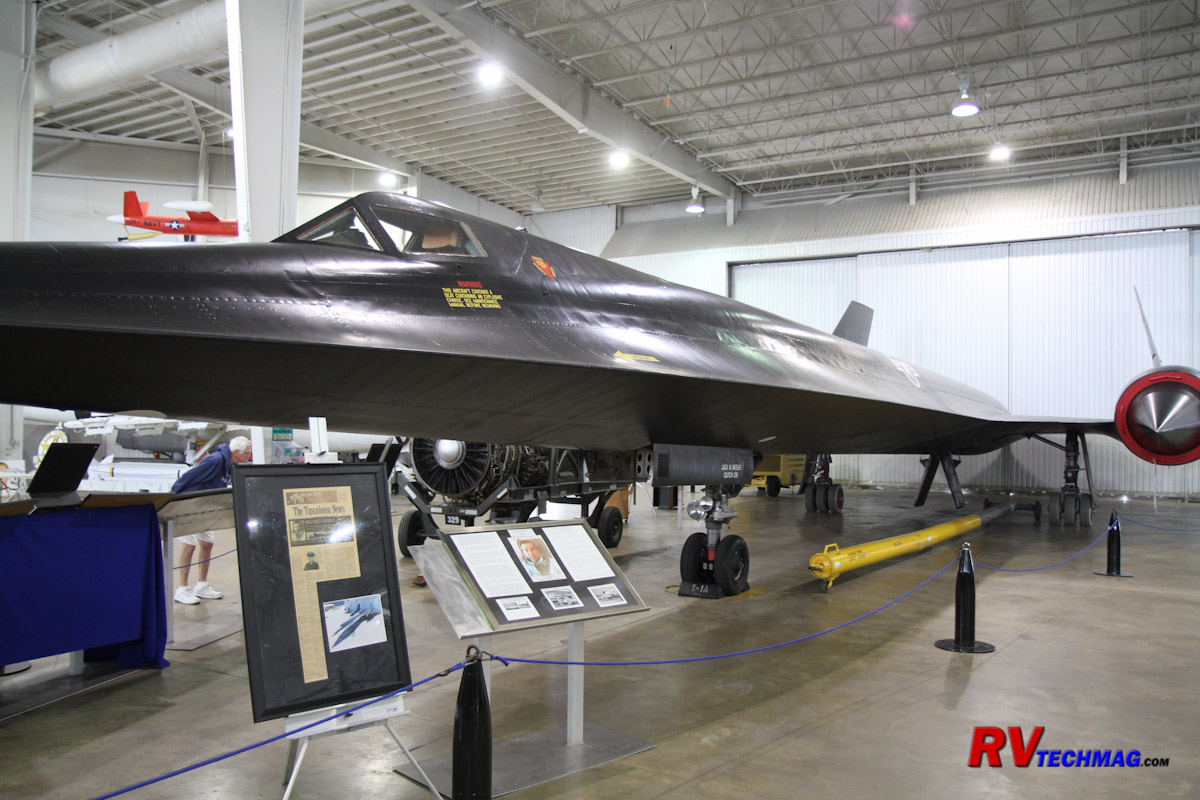
The A12 Blackbird is the fastest airplane in the world. It can fly at Mach 3 at altitudes of 90,000+ feet and take photos
with 8" resolution at that altitude. This was the CIA's version of the Air Force SR-71.
|
USS Drum

The USS Drum is a Gato class submarine from World War II. Launched May 12, 1941 by the Portsmouth Navy Yard it
is the oldest remaining American submarine in the world. The USS Drum was donated to the USS Alabama Commission on April 14, 1969 and
was opened to the public on July 4, 1969.
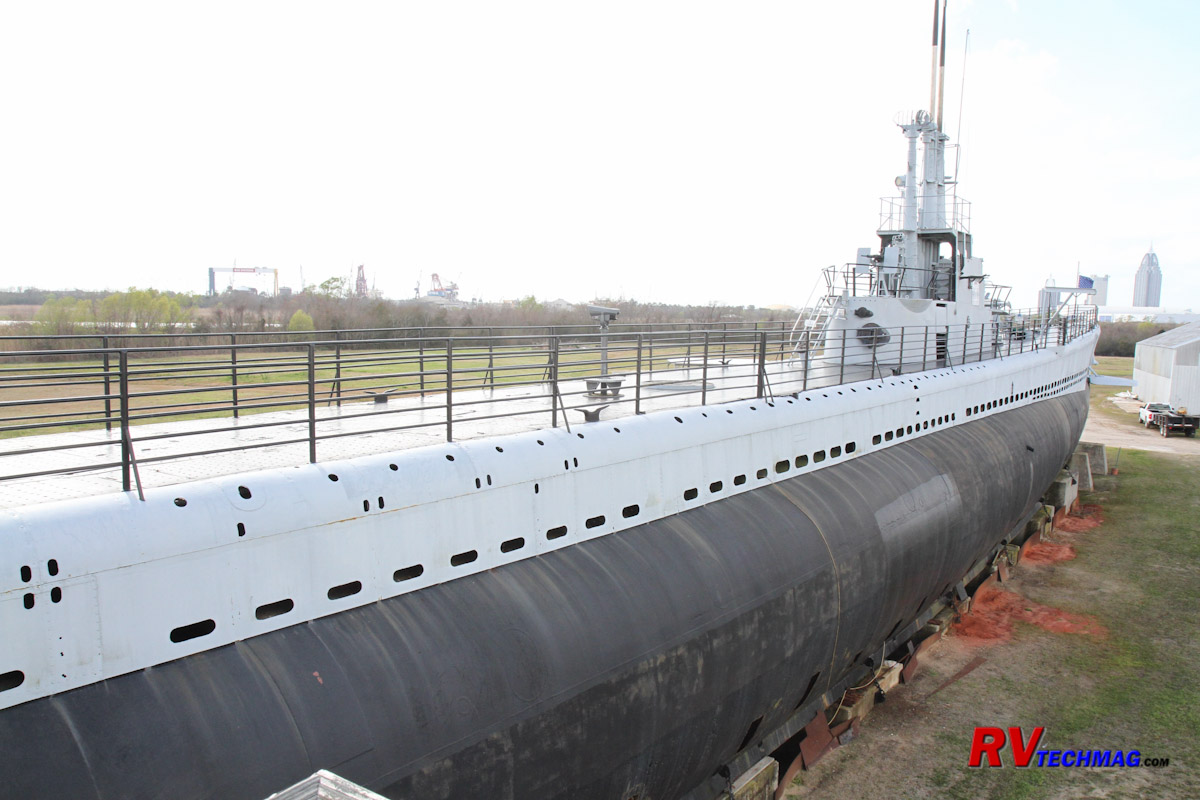
The USS Drum is situated on dry ground on one side of the parking lot. It was moved there in 2001 from its sea berth after it suffered
damage during the storm surge of hurricane Georges. The project of moving the Drum garnered several engineering awards. On going
restoration efforts continue to repair damage to the hull and remove the lead ballast.
|
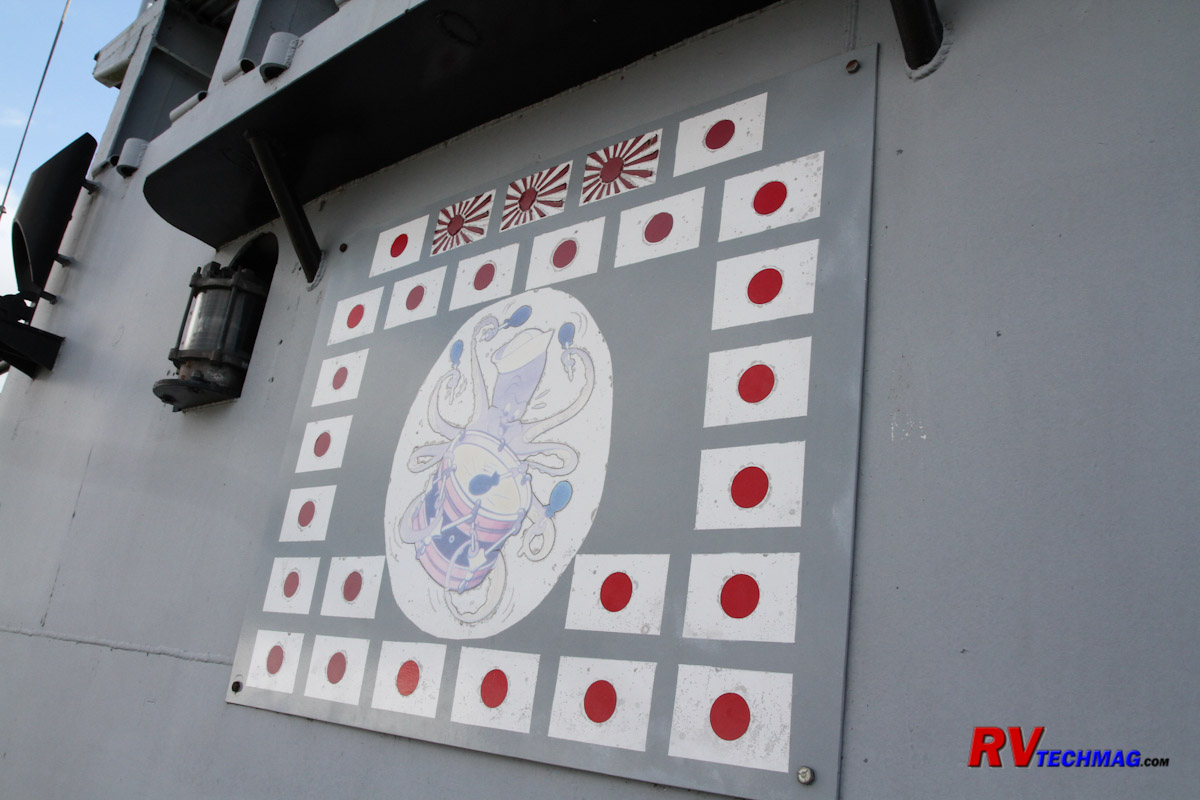
The Drum was one of the most successful submarines in World War II. It received a total of 12 battle stars and was
credited with sinking 15 enemy ships at a total of 80,580 tons, making the Drum eighth highest of all U.S. submarines
in total Japanese tonnage sunk.
Visitors climb aboard the ship via walkway to the rear of the
ship. After walking the deck, the ship is entered near the bow.
The 3" deck gun was mounted on the forward deck and used for surface attacks. A Bofors 40mm gun was placed just behind and above the
deck gun on a raised platform and is primarily used for anti-aircraft defense.
|
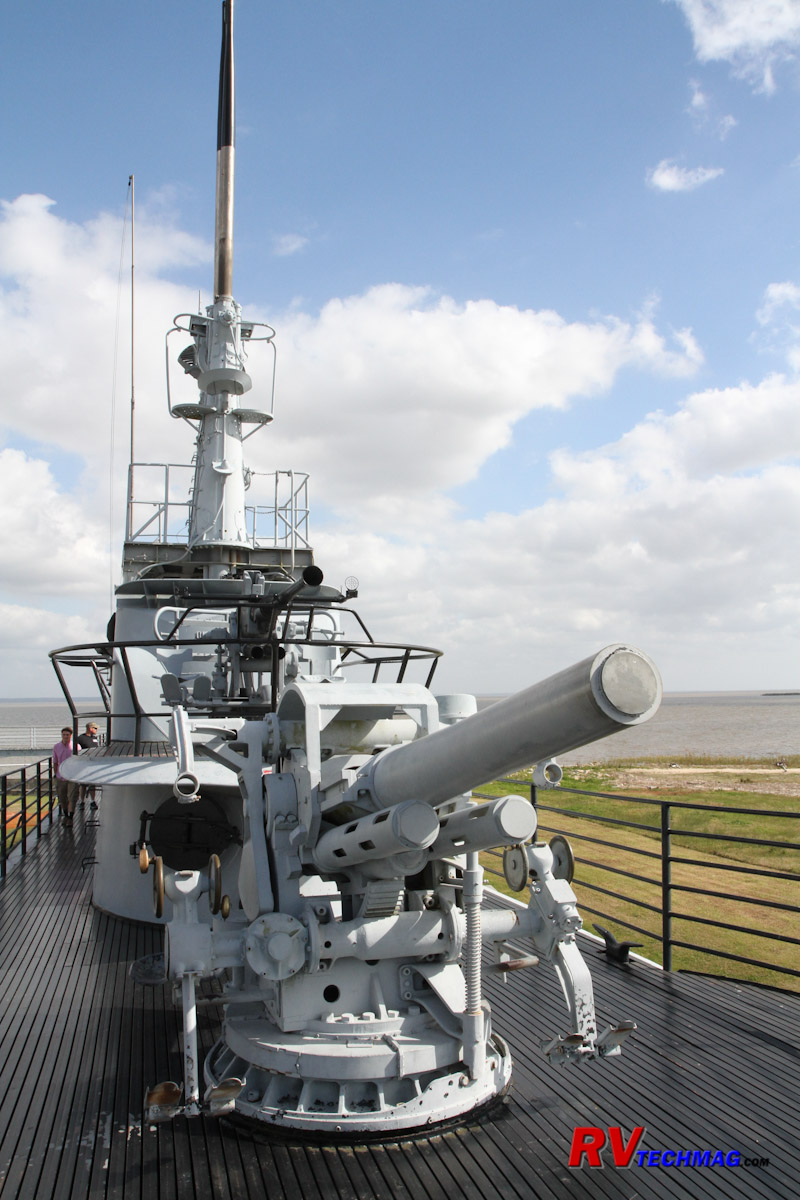
|
|
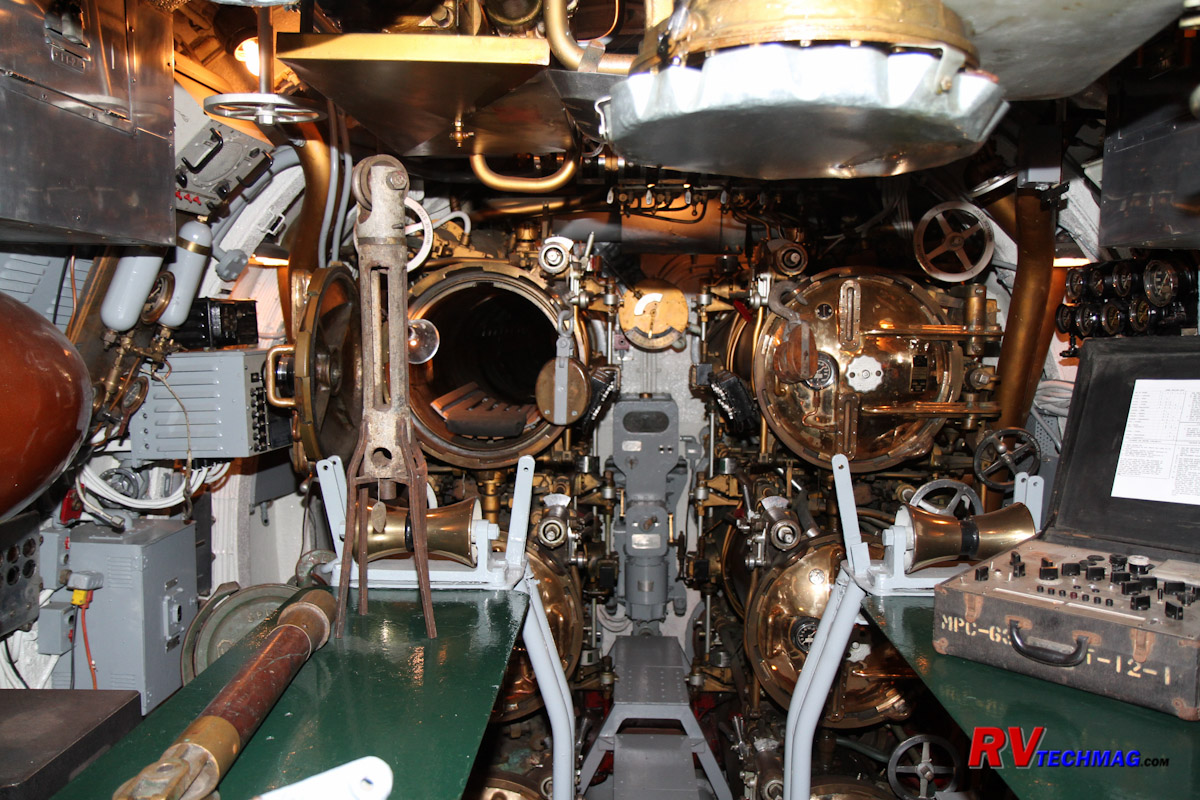
The forward torpedo room hold six torpedo tubes.
|
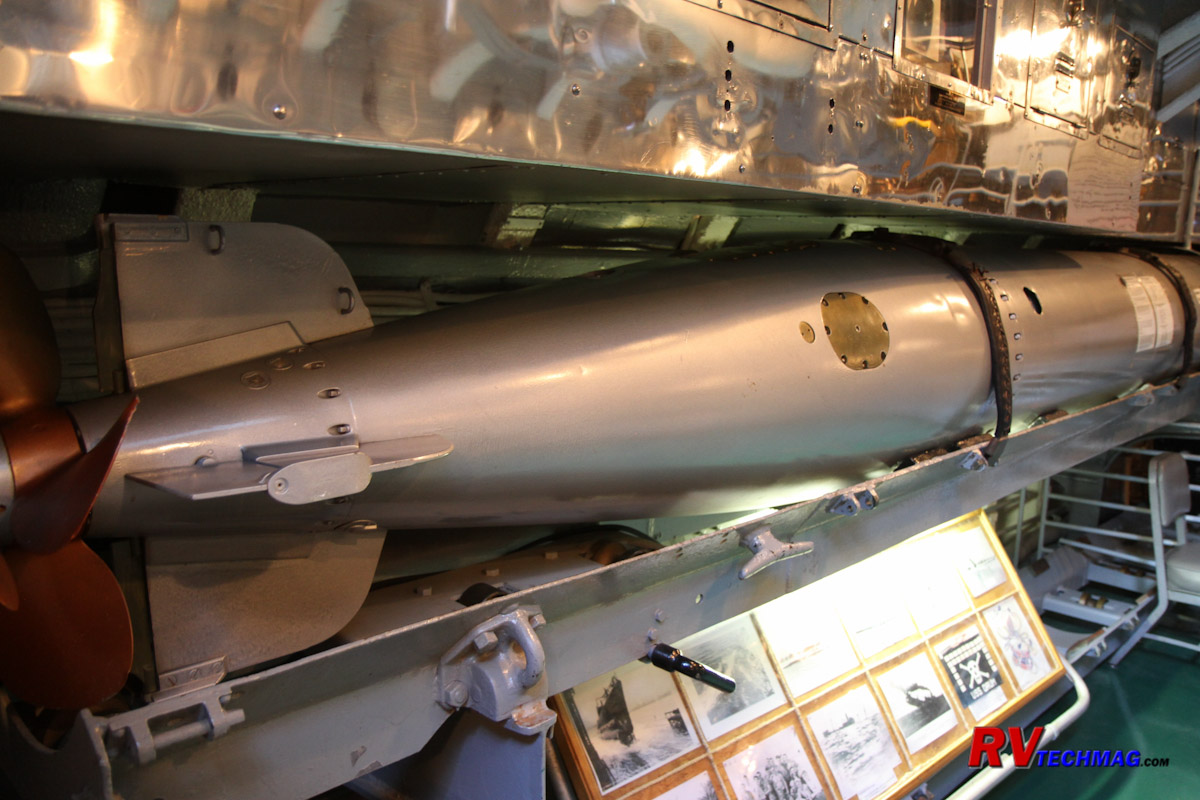
Torpedoes are stored in racks, ready to be loaded into a tube when ready.
|
The forward torpedo room is the real business end of the submarine. 21" diameter
torpedoes can be fired from six
tubes in the nose of the ship. The Drum can carry a total of 24
torpedoes although some of these are held in the aft torpedo room for
firing from the stern tubes. Torpedoes are stored in racks in each room and loaded into the tubes with ropes and pulleys or push rods.
The outer doors are closed and the tubes pressurized with air. Once loaded the outer doors are open the
torpedoes are launched with
compressed air and the electric driven propellers power the
torpedoes to their target.
Space is limited aboard a submarine.
Submarines operated 24 hours a day and crew members are berthed in "hot racks",
which means that crew members share each bed between shifts. The cramped Captain's Cabin is one of the more spacious areas.
The control room is all business. The Christmas Tree
displays green and red lights indicating that everything is
safe to dive. The various valve handles control trim and ballast tanks. The large wheels on the right control the diving planes. Depth
meters diving angle meters are flanked by numerous valves and controls used to dive or surface the ship.
|
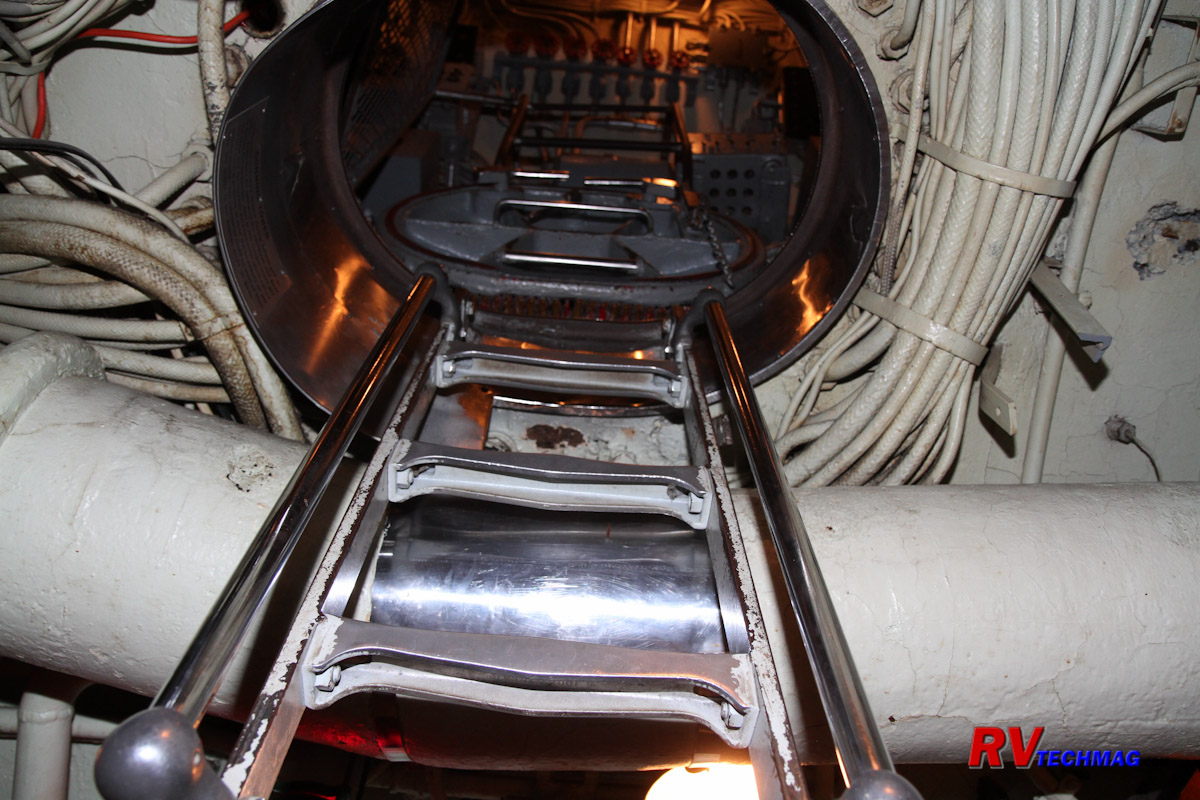
The conning tower is accessed by climbing a ladder up through a narrow passageway.
|
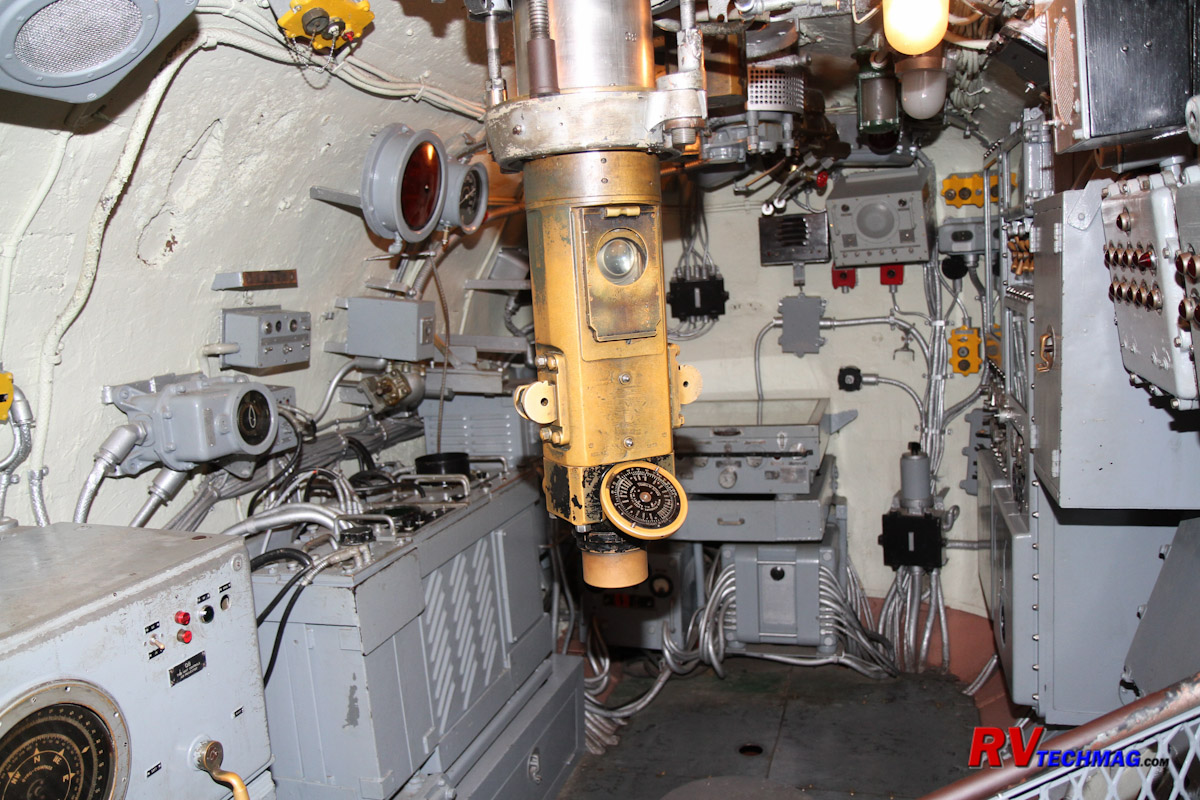
The conning tower is where the periscope is located. All of the controls for firing the
torpedoes is found here.
|
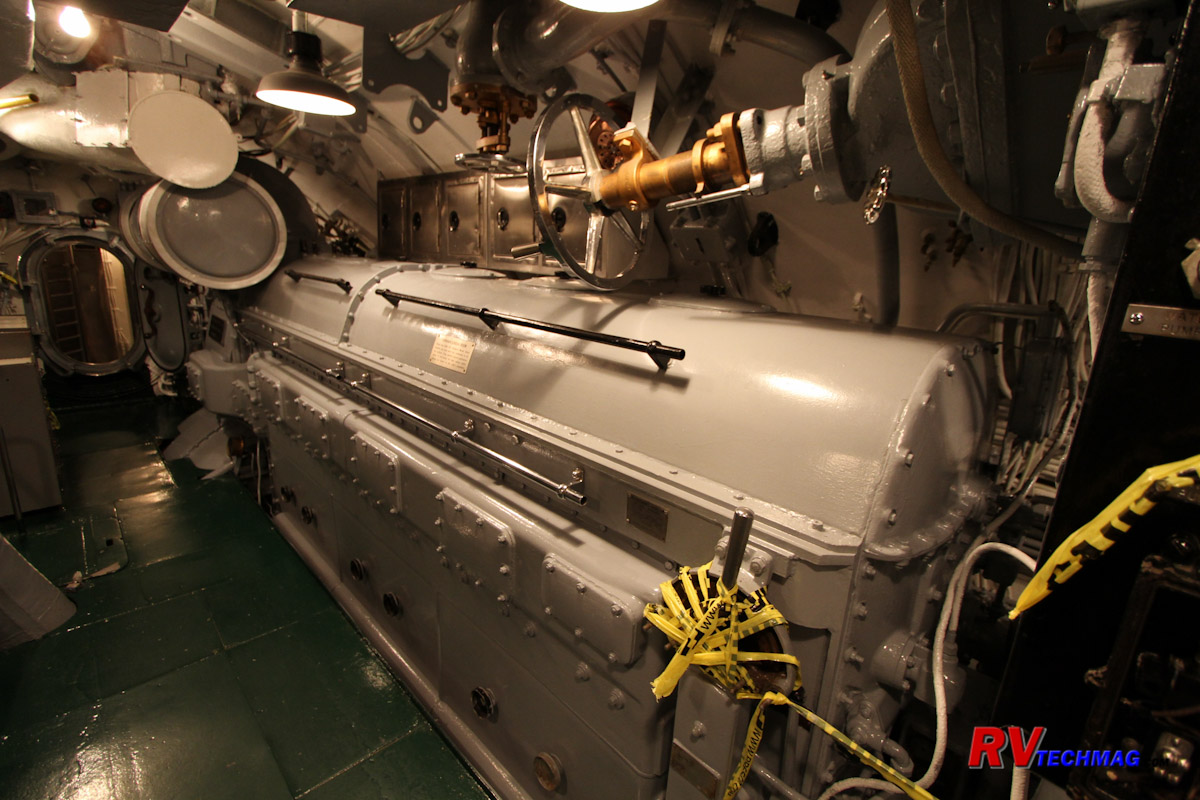
The forward engine room contains two 1600 HP Fairbanks-Morse diesel engines which operate generators to power the electric
motors that drive the propellers while on the surface.
|
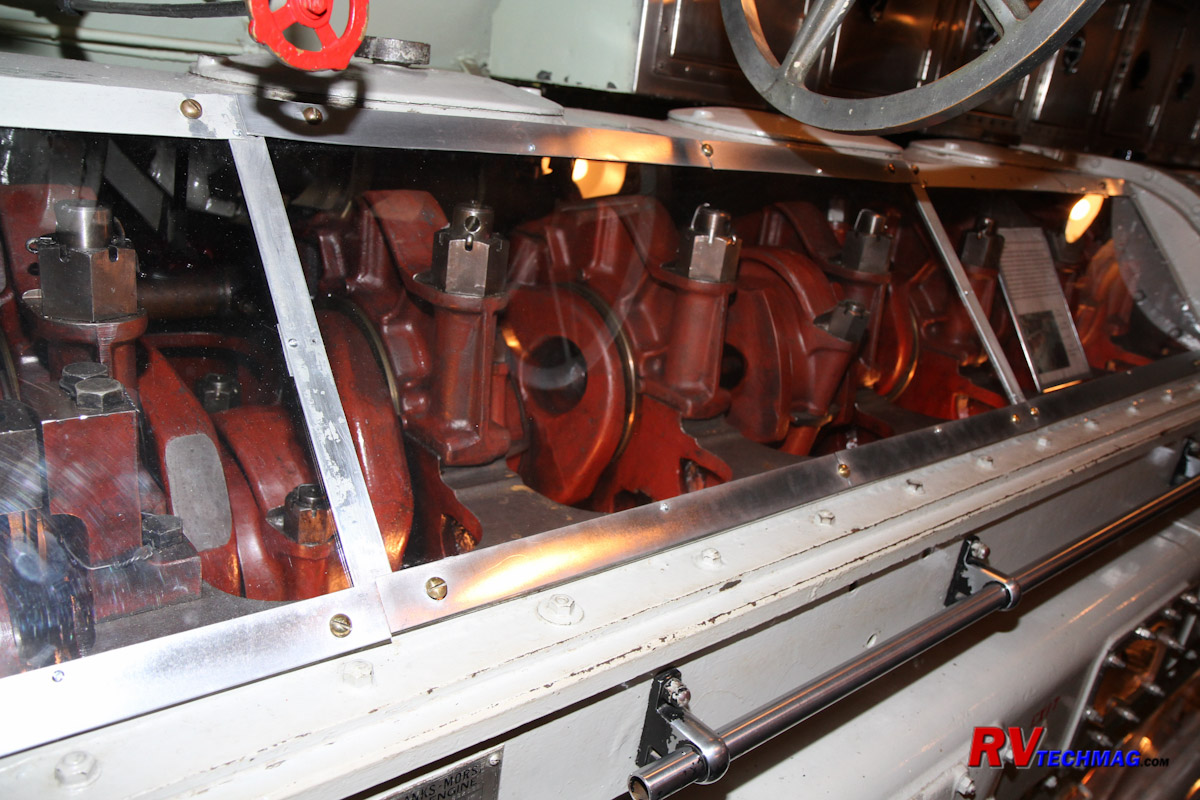
There is a pair of engines in the aft engine room as well. One of these engines has been cut open to display its
crankshaft. The engine is not upside down but has two pistons in each cylinder with one crankshaft at top and another
at the bottom. It uses ports instead of valves and is a very simple and reliable engine. Parts are still available today.
|
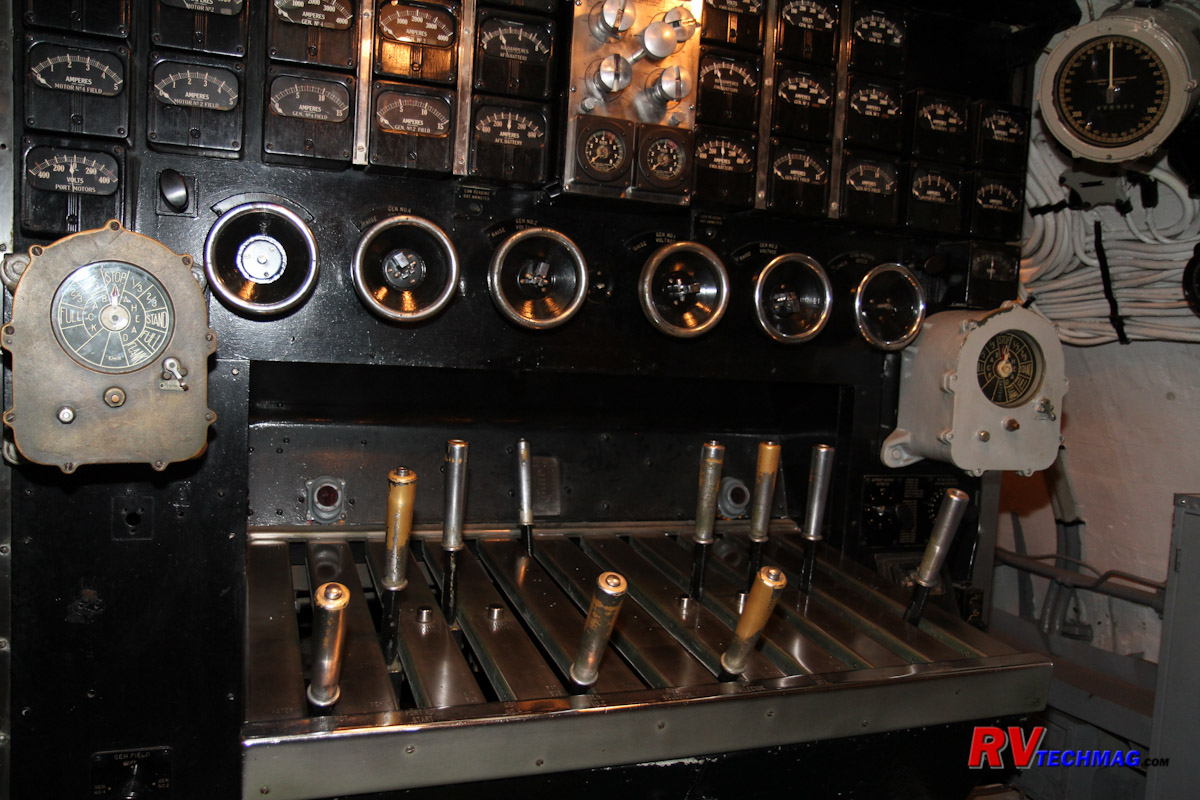
The various transmission and throttle controls in the aft engine room control the
speed and direction of the propellers. The
electric motors can run off of battery power when submerged and in silent mode.
|
|
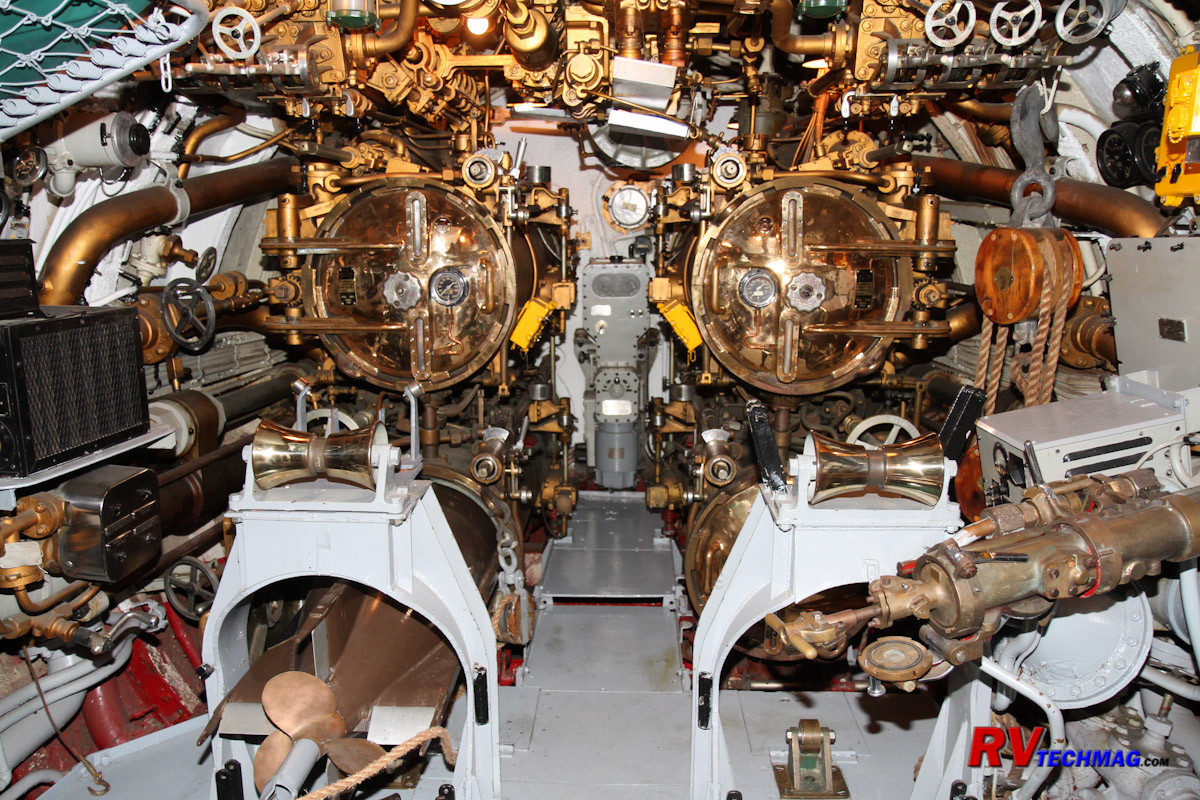
The aft torpedo room holds four tubes. Torpedoes are moved from
their racks to the tubes via block and tackle.
|
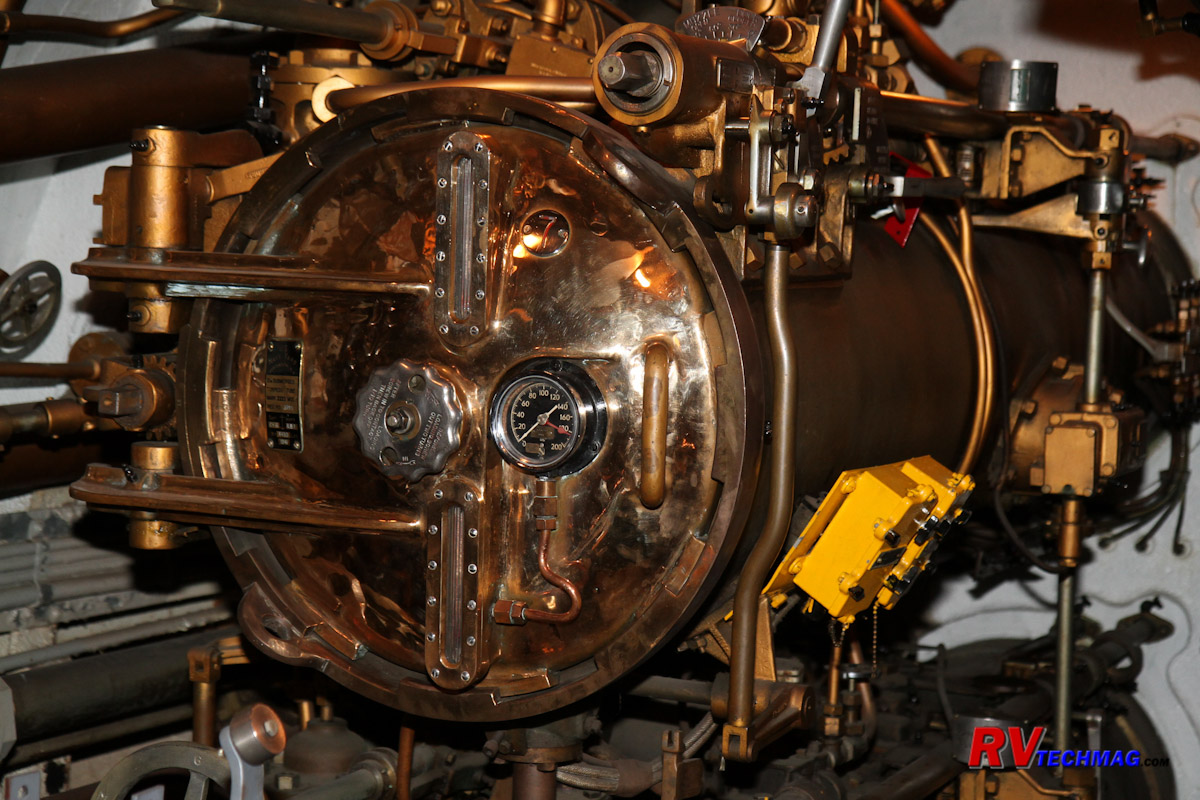
Torpedo tubes use air pressure to launch the torpedoes so that they can begin their run to the target.
|
The USS Drum is an excellent example of the type of submarine that the U.S. used during World War II. The
diesel-electric subs of the Gato class made up the backbone of the Navy's Silent Service. Many were lost during the war and surviving
boats were scrapped. The USS Drum is now the oldest remaining submarine in the world and it's continuing restoration efforts, supported
by a group of former submarine vets, offer a glimpse into what life under the seas was like at that time.
Source
USS Alabama
(251) 433-2703
www.ussalabama.com
Return to Home Page
If you enjoyed this article be sure to recommend RVtechMag.com to your friends, like us on Facebook or Twitter
or subscribe to our RSS feed.



|







































